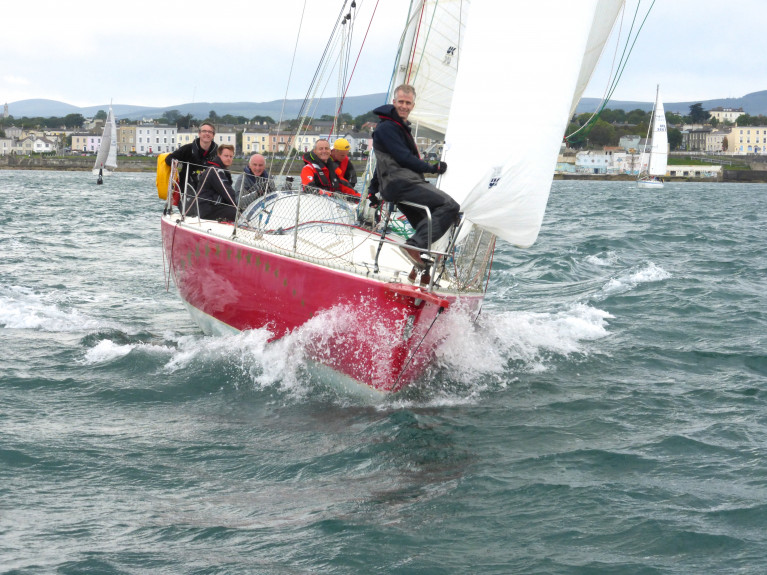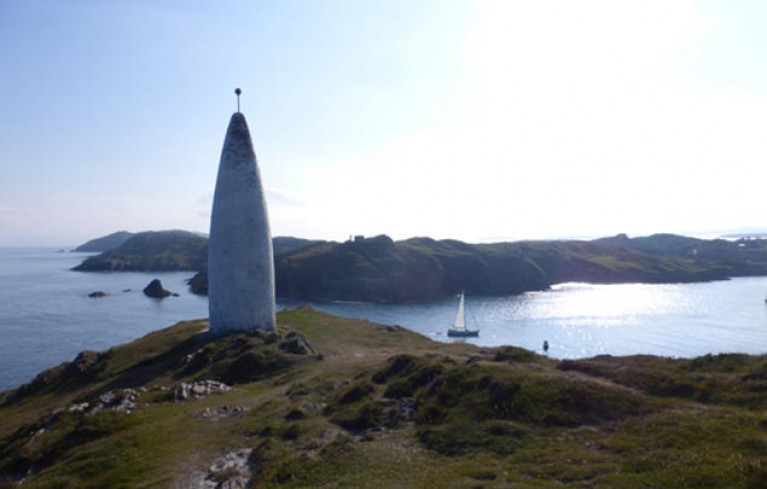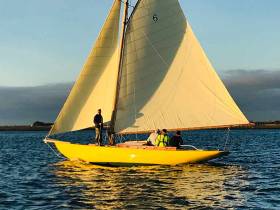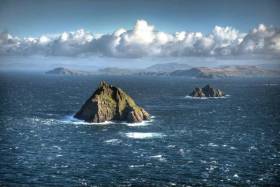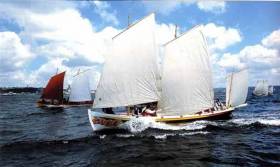Displaying items by tag: W M Nixon
Irish Cruising Club To Mark Centenary of Conor O'Brien's Circumnavigation at Sligo Dinner This Weekend
The Irish Cruising Club (ICC) gathers in County Sligo for its annual dinner this weekend, at which Commodore Dave Beattie will launch a new edition of Conor O'Brien's 'Across Three Oceans' to mark the centenary of the circumnavigation.
As Afloat reported previously, The new Irish Cruising Club/Royal Cruising Club book is the sixth edition of O’Brien’s pioneering account of his global circumnavigation south of the Great Capes with the 42ft Baltimore-built traditional gaff ketch Saoirse in 1923-1925. Compiled by Alex Blackwell and a special ICC/RCC Publications Committee, it includes extra material about O’Brien’s personal background and other after-thoughts on ocean sailing, which he added with additional analysis and further sea-going experience.
 A new edition of Conor O'Brien's 'Across Three Oceans' marks the centenary of the circumnavigation and will be launched at the ICC dinner in Sligo
A new edition of Conor O'Brien's 'Across Three Oceans' marks the centenary of the circumnavigation and will be launched at the ICC dinner in Sligo
Fastnet Award
The ICC Dinner will also see the presentation to W M Nixon, of this parish, with the club's premier trophy for his 'exceptional achievements and for excellence in or closely related to cruising under sail'.
The Fastnet Award is a perpetual trophy that is not awarded every year, and Sligo will be the ninth occasion on which it has been presented.
Previous recipients include Paddy Barry and Jarlath Cunnane (inaugural Award, 2005), Robin Knox-Johnston, Commander Bill King, Killian Bushe and, in 2020, the Royal Cork Yacht Club.
The Fastnet Award is made for exceptional achievements and for excellence in or closely related to cruising under sail. This year it is made to W. M. (Winkie) Nixon who has been described by the late Theo Rye in Classic Boat magazine as “the doyen of yachting correspondents”. Rye has also written in reference to the whereabouts of a once famous yacht that if “Winkie doesn’t know, then nobody does”.
W M Nixon’s childhood was in a boisterous sailing family – he’d five siblings - living in a large and tall house built in several not necessarily harmonious architectural styles, and set in five acres on the shores of Ballyholme Bay to the eastward of Bangor on the south side of Belfast Lough. Despite its massive construction, the building’s upper storeys shook in severe nor’east gales in winter. But it was a young sailor’s paradise in summer, and with his father and uncle each owning a boat of the local Waverley Class, and then going into partnership as founder members of the Royal Ulster YC’s Alfred Mylne-designed No 1 Class (better known as the Glen Class) in 1948, he was seldom out of boats.
At the age of nine, he became the owner of a new 14ft Ballyholme Insect Class dinghy as the result of winning some family swimming competition. By 1957, aged 15, he was making his first cruise with this little boat Grasshopper and a tent, down the sailable length of the Upper River Bann from Portadown and across Lough Neagh, then down the Lower Bann to a conclusion in tidal waters at Coleraine, as his parents’ only stipulation was that he and his crew of one did not attempt to sail back to Ballyholme via the Atlantic coast and the North Channel.
 The Ballyholme 14ft Insect Class Grasshopper was a multi-purpose, multi-people vessel used for racing, messing about, and cruising. Photo: W M Nixon
The Ballyholme 14ft Insect Class Grasshopper was a multi-purpose, multi-people vessel used for racing, messing about, and cruising. Photo: W M Nixon
At the end of the 1957 season, Grasshopper was sold, and he and his brother James moved on to the 26ft Swallow class, which was growing at RUYC, a boat somewhat like a small Dragon which - despite its design attribution to powerboat constructor and shipbuilder Tom Thorneycroft – is now known to be a creation of his Chief Draftsman, O’Brien Kennedy. With the Swallows, racing for trophies and winning more than a few was dominant, but there was an element of distance sailing with visits to the Strangford Narrows regattas involving a 25-mile coastal passage.
At Bangor Grammar School - on whose premises he spent the absolute minimum of time - his few contributions to the school magazine were about sailing, and by 1960 and now in college, he’d had his first item of paid-for sailing journalism published in Yachting World. 1960 also saw his first keelboat cruise, to the Clyde with future ICC members Ed Wheeler and Pete Adams together with others aboard the 9-ton 1912-built yawl Ainmara. She was chartered for a very modest sum from Belfast Lough’s “sailing angel” Billy Doherty, and the venture saw The Yachtsman added to his revenue-generating print outlets.
 Billy Doherty, Belfast Lough’s “sailing Angel” for young would-be cruising folk, aboard his beloved Ainmara. Photo: W M Nixon
Billy Doherty, Belfast Lough’s “sailing Angel” for young would-be cruising folk, aboard his beloved Ainmara. Photo: W M Nixon
He’d been at Queen’s University Belfast, reading for an Honours Arts Degree in Psychology in a very leisurely four-year course, since 1958. As he was meant to be in Liverpool University studying architecture, it was a telling illustration of the cock-ups of which the exam-obsessed Northern Ireland education system was effortlessly capable.
He had done unusually well in exams in unexpected subjects in the Senior Certificate to facilitate his exit from school just as quickly as possible, yet despite everything and everyone pointing to him doing Honours History at Queen’s rather than Architecture in Liverpool – which was now eliminated from the options - he ended up in the relaxing backwater of the Psychology Department in QUB, ineligible for Honours History thanks to Latin having been dropped at school in order to streamline his progress through a shortened force-feeding education system, cunningly devised for a select few by the clearly certifiable headmaster at BGS.
Ultimately this was all to the good, as it honed his exam skills to such an extent that he emerged with a useful 2:1 despite only working for about a week each time exams came round. As for Liverpool, the very idea of having been there is now unthinkable, for in Belfast most of his interest and energy was taken up in the entertaining QUB Sailing Club with such people as Colm MacLaverty, Mick Clarke, Ed Wheeler, Mike Balmforth and Maurice Butler, with any other time being devoted to the social and external education possibilities more readily available in Belfast than Bangor.
 The 23ft Skal was restored from near dereliction, and cruised single-handed in southwest Scotland in 1961. The mainboom has been raised to permit the 6ft pram dinghy to be carried on the coachroof.
The 23ft Skal was restored from near dereliction, and cruised single-handed in southwest Scotland in 1961. The mainboom has been raised to permit the 6ft pram dinghy to be carried on the coachroof.
On the cruising front, in 1961, he bought a semi-derelict 23-footer sloop called Skal, and restored her in record time to undertake a single-handed cruise in southwest Scotland before selling her to a determined purchaser in Helensburgh on the Clyde. It eventually resulted in a three-parter story in The Yachtsman. This fit-out and cruise had initially seemed a reasonably profitable venture, but by the time the outstanding bills were settled back at Tedford’s, the 19th Century-style ship and yacht chandlers on the quays in Belfast, there was little enough left, and it was all – and more - in the hands of the publicans of Belfast and Bangor by Christmas.
Suitably chastened, in 1962, he crewed with Dublin Bay’s Peter Odlum (met as a result of university racing in Dun Laoghaire) in his 8 Metre Cruiser/Racer Namhara in Clyde Week, and then hitch-hiked to the Hamble for a delivery cruise to Carrickfergus with the 52ft 1898-built former Ramsgate trawler Armorel which, though he wasn’t aware of it at the time, confirmed his seagoing credentials for ICC membership with sufficient power to overcome any social and personality drawbacks, while also providing more material for merchandisable maritime verbiage.
 The former Ramsgate trawler Armorel provided some very varied seagoing experience in 1962. Photo: Mike Balmforth
The former Ramsgate trawler Armorel provided some very varied seagoing experience in 1962. Photo: Mike Balmforth
In 1962 he also competed the first RUYC Ailsa Craig Race in the totally characterful gaff cutter Marie Michon, resulting in his first sale of words to an American magazine, and he broke into Yachting Monthly with an article about cruising in West Scotland with Ed Wheeler on the latter’s uncle’s former Belfast Lough Star class Corona of 1901 vintage.
Meanwhile, he and Mike Balmforth found themselves on the Editorial Committee for the new magazine Irish Yachting, making 1962 a year with a certain Dun Laoghaire emphasis, for thanks to Cass Smullen and Paul Johnston, he was one of a group of university sailors invited to race the Dublin Bay 21s for their last season in their original jackyard topsail rig, as they started to change to Bermudan rig in 1963. There are very few sailors with such a specific and historic experience still left.
1963 was a special year, as he’d become a member of the Irish Cruising Club at the age of 20 thanks to northern committee member Darty Glover, who in addition to being Vice Commodore RUYC, was a lecturer and physiology researcher at Queen’s. Darty also nobly undertook the supposedly honorary role of Commodore of QUBSC, which was anything but honorary as he was often the only adult in the room, and sometimes had to go bail for an increasingly boisterous and expanding membership in what was Nixon’s final year as Captain. He left on a high, leading the QUBSC Team that finally won the Elwood Salver for an annual team race in Dun Laoghaire against TCD, which TCD had - until 1963 – won and retained continuously since it was inaugurated in the early 1930s.
 Athletes at the ready. Ed Wheeler and W M Nixon waiting to race for Queens University against Trinity Dublin in the Elwood Salver of 1963 – which they won for the first time since its inauguration in the early 1930s.
Athletes at the ready. Ed Wheeler and W M Nixon waiting to race for Queens University against Trinity Dublin in the Elwood Salver of 1963 – which they won for the first time since its inauguration in the early 1930s.
Now working in Belfast and married for the first time (his daughter Patricia and her husband Davy Jones of Howth are both ICC members) he saw the three seasons of 1963 to 1965 with annual fortnightly cruises in Ainmara with Ed Wheeler and the late Russell O’Neill, both of whom were to become ICC members.
1963 was to the Outer Hebrides, 1964 round Ireland without an engine, thereby accidentally establishing a speed record which stood for some time, and in 1965 they went to St Kilda, where a suddenly approaching low of “972 and deepening” bound for the Hebrides would have made for an interesting time in Village Bay if it had passed to the south of the island, but it zoomed past close to the north.
 Ainmara (left) in Village Bay, St Kilda, in June 1965 the morning after a deepening Low of 972 had passed close to the north. Photo: W M Nixon
Ainmara (left) in Village Bay, St Kilda, in June 1965 the morning after a deepening Low of 972 had passed close to the north. Photo: W M Nixon
All of these cruises were awarded the ICC’s Fortnight Cup and duly written up for The Yachtsman, and meanwhile, in 1964 before cruising round Ireland, he was persuaded by Darty Glover to charter Ainmara for the annual Round Isle of Man Race – then the numerically largest offshore event in the Irish Sea. With his brother James (a TCD medical student who became Irish Helmsman’s Champion in 1965) and two others as crew, the overall win was pulled off through some glorious flukes, resulting in another article snapped up by Boating of New York, and a report for Irish Yachting with which his involvement was expanding, while Yachts & Yachting was also taking regular offshore racing stories and he was now also Irish Correspondent for the popular Around the Coast section in Yachting Monthly.
1966 saw a detailed cruise in Ainmara with Pete Adams ICC to West Cork – a different place in those days – and much North Channel offshore racing (sometimes including Scottish ports) while later sailing as a member of the RUYC crew that delivered the 66ft Royal yawl Bloodhound from Belfast to Gosport - all of it grist to the mill of sailing stories through outlets on both sides of the Atlantic.
 Ainmara in Glandore, June 1966 Photo: W M Nixon
Ainmara in Glandore, June 1966 Photo: W M Nixon
Having found that he was still too young for domesticity, he returned to singleton status, but what looked like being the footloose and fancy-free season of 1967 took on a real purpose with short-notice involvement in a cruise to Iceland from Portstewart on Ireland’s North Coast with the 25ft Vertue Class cutter Icebird.
Basically, it was a mountaineering venture to the Myrdalsjokul icefield in the middle of Iceland, with little Icebird as the expedition ship and Nixon as the nautical input. As they departed northward in late May after a very hasty fit-out, the season was early for high-latitude North Atlantic voyaging, so they were treated to a gale or two of winter ferocity on an eight-day passage. But it was all character-building for the up-country experiences, for with the location-delivery “Expedition Vehicle” being an ordinary Volkswagen Beetle rented in Reykjavik, Nixon found himself alone, driving back across the unmade roads in a vast landscape and gathering dusk, incurring the inevitable punctures with such regularity that he was forced to make the welcome discovery that each utterly isolated farmstead was well equipped with effective puncture repair kits, and generous in their use.
He flew back in an ancient Dakota for a month in Ireland and some offshore racing and a little work, and returned on the first flight with Loftleidir’s pride-and-joy, a brand new Boeing jetliner, to find the mountaineers were still just about talking to each other, but it was with a changed ship’s company that he hoped to sail northabout around Iceland before heading for home. However, persistent gale force-plus headwinds and the boat’s limited windward ability under her original cotton sails put paid to that, yet even so it was still fourteen days out of Reykjavik and long in an engine-less condition when they finally came in through Vatersay Sound to Castlebay on Barra in the Outer Hebrides and a great feasting on newly-bought fresh oranges, followed by an Icebird-redeeming fast reach over the final hundred miles back to Portstewart.
 The Vertue Class 25ft cutter Icebird off Portstewart on her return from Iceland – she still set her original 1953 cotton sails. Photo: W M Nixon
The Vertue Class 25ft cutter Icebird off Portstewart on her return from Iceland – she still set her original 1953 cotton sails. Photo: W M Nixon
As neither the owner nor his nephew (the co-leader of the Icelandic mountaineering expedition) had the time availability to do anything with Icebird, Nixon had the loan of her for two or three years, and secured a winter berth in the big shed at Erskine’s characterful boatyard in Whitehouse on the shores of the seemingly remote territory of north Belfast. She was in the shed alongside Ainmara, now owned by Dickie Gomes after Billy Doherty’s death in 1966.
First met in the Skal year of 1961, Dickie had become a firm friend and fellow ICC member with many miles already logged and many more – some in extraordinary craft – still to be sailed, so the crack in Erskine’s shed was good as Nixon had been joined by Ed Wheeler to give Icebird a complete makeover and replacement sails in order to voyage south the following summer, and simply continue sailing south.
 Two boats which figure prominently in the story – Ainmara and the Hustler 30 Turtle in Strangford Lough in 1984.
Two boats which figure prominently in the story – Ainmara and the Hustler 30 Turtle in Strangford Lough in 1984.
But that grand plan was blown asunder in April 1968 when Nixon had a coup de foudre on meeting Georgina Campbell for the first time in a bar in Belfast’s university district while supposedly homeward bound from boat work. By the time the transformed Icebird was afloat, “simply sailing south” had been edited back to cruising northern Spain. It was all being done on a shoestring, but in Coruna they met with mysterious characters who suggested to Ed that crewing positions were available across the harbour on a rusty Liberty Ship that was being delivered – “smuggled” was perhaps a more appropriate term - out to very Communist China for scrap, and they said it was easy money for old rope, with an interesting visit to the Far East and anywhere else he fancied thrown into the bargain.
Ed got himself signed on to join in a fortnight, so the duo cruised Icebird eastward with much enjoyment along Spain’s often spectacular North Coast, and parted company in San Sebastian for Ed to return to Coruna to join ship, while Nixon made his way back to Ireland single-handed with a fortnight’s agreeable coastal cruising in south Brittany, and a visit to Cornwall to see Georgina at home at her parents’ house and continue to plight his troth, followed by a somewhat rugged upwind passage to Kinsale in very unsettled weather.
Meanwhile Ed’s supposedly easy ship’s passage of a few weeks from Coruna to China became many months of total nightmare, but it has recently resulted in a hugely entertaining lockdown-created article in the The Marine Quarterly. And for Icebird and Nixon, as with the Iceland cruise the Spanish jaunt provided further material for selling published stories on both sides of the Atlantic, while the return to Northern Ireland revealed that an idea first aired in 1964 had returned with renewed vigour.
During that successful Round Isle of Man Race of 1964, one of the crew aboard Dick & Billy Brown’s Black Soo from Portaferry as she chased Ainmara round the island was Ronnie Wayte, an inventive bundle of energy who had a multi-purpose factory in Carrickmacross in County Monaghan where, with his newfound enthusiasm for offshore racing, he decided to build a Fastnet Race contender. And after Ainmara’s freak win, he’d decided that Nixon was the man to do it with him and his team, with the 1969 Fastnet Race in mind.
The factory was in Carrickmacross because, as a Border County, Monaghan was eligible for all sorts of industrial grants, and as Carrickmacross was the nearest town to Dublin, it was heaving with new or re-purposed factories where all sorts of crazy ideas were being pursued. Nevertheless a 35ft offshore racer from scratch was crazier than most, particularly as the ramifications of running a business venture on the very edge of viability meant that work didn’t start until April 23rd. Yes - April 23rd 1969. Yet somehow – with the booster of having won an offshore race in the Irish Sea - Mayro of Skerries was on the start line in Cowes on August 8th 1969 for the RORC Fastnet Race, and finished 122nd overall out of 256.
 “It took a helluva lot of boats to beat her”. The 35ft Mayro of Skerries – built in three months from scratch in Carrickmacross in County Monaghan – placed 122nd out of 256 finishers in the 1969 Fastnet Race
“It took a helluva lot of boats to beat her”. The 35ft Mayro of Skerries – built in three months from scratch in Carrickmacross in County Monaghan – placed 122nd out of 256 finishers in the 1969 Fastnet Race
Although considerable comfort could be drawn from the supposed quality of some of the boats behind her, Ronnie Wayte subsequently developed a more sensible approach to boat procurement. But in going through various Skerries ownerships, Mayro was eventually wrecked in the beach in that exposed anchorage. Yet a bit of her will probably survive for ever – when her original Carrickmacross-made fibreglass mast proved to be too flexible, it was replaced in jig time by an expertly-made alloy mast, but happily the fibreglass mast proved more than sufficiently robust to be the new Skerries Sailing Club flagstaff, and it’s still there.
Nixon did well out of it, as his account of the Mayro story was to go viral or whatever was its printed 1969 equivalent in America, and he sailed her home to Ireland with the happy thought that post-race in the bar of the Royal Western in Plymouth, a fellow-member of the occasionally-meeting Irish Yachting Editorial Committee, cartoonist Bob Fannin, revealed that money made from the sale of the News of the World Sunday newspaper in London to Canadian mogul Roy Thompson was set to flood into Dublin to finance a new comprehensive publishing group, and they were thinking of including Irish Yachting in their proposed stable of consumer magazines, with Nixon as the Editor.
 “Whatever next?” Nixon homeward bound post-Fastnet aboard Mayro in August 1969, after hearing (over a drink) that he might be in line to be the Editor of a fully-financed Irish Yachting.
“Whatever next?” Nixon homeward bound post-Fastnet aboard Mayro in August 1969, after hearing (over a drink) that he might be in line to be the Editor of a fully-financed Irish Yachting.
And so it came to pass that by early 1970 he and Georgina were set up in Dublin with herself doing a post-Grad at Trinity and subsequently teaching, while he found himself with a brand new Ford Capri company car, yet still working as a free-lance as was the practice among many of the journalists in that short-lived but mightily entertaining enterprise.
Home was a flat in Baggot Street, right at the Patrick Kavanagh-haunted heart of a city that was coming pleasantly to improved economic life without being obnoxiously busy and noisy. They could usually find legal parking for the much-travelled car right outside the front door, while the flat included a working telephone whose bill was apparently being paid by the H Williams Supermarket on the corner, yet it was impossible to convince An Post that this was so, even while they continued to use the phone at no cost to themselves
The local hospitality establishments were in a golden mile from the Intercontinental in Ballsbridge to the Horseshoe Bar in the Shelbourne, and the handiest - the unbelievably rural Toner’s - was right next door. On the water, the sailing calendar was busier than ever, with the policy of continuing to sail as much as possible, while also writing about it in an increasing number of outlets - between hectic monthly bursts of magazine editing - continued on an upward curve. 1970 included being left in Cork for the Royal Cork Yacht Club Quarter Millenial Regatta Week with a Swan 36 which he’d helped race from Belfast Lough in the main offshore event, with the owner – before he rushed home - stipulating only that the boat be back in Donaghadee within a fortnight.
That first Cork Week of 1970 was just a 30-boat affair with racing on only three days, but Francis Chichester was in town for the completion of his new Gypsy Moth V in Denis Doyle’s Crosshaven Boatyard, and in the absence of Lady Sheila he was having the time of his life in presiding at the daily prize-givings, with the week ending well for the absent owner’s Swan 36 with the overall win – raced with a minimal family crew - in the concluding Crosshaven-Kinsale race, resulting in the careful shipboard conveyance of an enormous Waterford crystal rose-bowl back to Donaghadee.
 The Hustler 35 Setanta now has Dun Laoghaire as her home port
The Hustler 35 Setanta now has Dun Laoghaire as her home port
There was involvement too in the Northwest Offshore Racing Association events out of Dun Laoghaire and Howth across to Wales, and in 1971 these acquired extra significance as they were used for training in Ronnie Wayte’s sensible new boat, the Holman & Pye Hustler 35 Setanta of Skerries, which seemed to provide marginally better all-round performance than the S&S 34s in which the majority of Irish Cruising Club offshore racers competed. For in those days, offshore racing was an integral part of ICC activity, such that in 1975-78, having been RORC Rear Commodore in 1972-75, the great Denis Doyle was ICC Commodore, and was famous for putting through the AGMs, complete with the distribution of the then-admittedly-much-smaller selection of trophies, in just 25 minutes flat.
In due course it was time to grow up and move from Baggotonian Bohemianism out to a new house being built in a handy small development one street back from the waterfront in Howth, where Nixon had been a Howth YC member since 1969. This happened in the Setanta year of 1971, on the day that the great Jack Kelly-Rogers was on the tarmac at Dublin Airport to lead the welcome for the new Aer Lingus Jumbo Jets, and as the entire move out to Howth was made with the company Ford Capri in three journeys with all their goods and chattels on the roof-rack, RTE’s afternoon-long broadcast of the big event out at the airport on the car radio is part of the memory.
With an extraordinary crew of all the talents, Setanta had a good year, with her overall class win in the NWOA Championship secured before she’d even left for the Solent, where performance in Cowes Week improved such that in the Fastnet Race itself, they burned off all the S&S 34s to finish second in Class IV, beaten only by Alan Bourdon’s ready-planing Pionier 10.
1971’s mainstream sailing concluded for Nixon with a meeting of the great and the good in Howth after the Abersoch race to begin turning the NWOA into ISORA. With that concluded and followed by a decade of regular ISORA racing, 1972 was a “settling into living in Howth” year, with an able little Galion 22 which was family-cruised to West Cork. There, time was spent with Dermot Kennedy of Baltimore clearly enunciating his views as to what the proposed new Irish sail training vessel to replace Asgard should look like. When reported in Afloat Magazine (as Irish Yachting had been since March 1971) and read by new Minister for Defence Paddy Donegan ICC, the Kennedy Opinion resulted – eventually but directly – in the new Asgard II designed and built by ICC member Jack Tyrrell of Arklow.
On another tack, Nixon had started a weekly sailing column with the Irish Times at the suggestion of the then Quidnunc of The Irishman’s Diary, Seamus Kelly. This resulted in an offer by the paper to fund a three weeks on-site Nixon coverage of the up-coming 1972 Olympic Games Sailing Regatta in Kiel in which Ireland was putting forward a strong team. When the first report appeared, the Irish Independent and the Cork Examiner requested syndication which was duly provided, but for some reason these high-profile newspaper associations offended the amour propre of the already-floundering publishing group which had taken on what was now Afloat Magazine, so for a while Nixon was carrying the continuing publication of Afloat on his own, with sterling help from Georgina.
However, with demand increasing with a new regular vaguely cruising-oriented column for Yachting World which was meant to run for 12 months but ran unbroken for 25 years, Nixon was able to claim that he had to keep sailing despite new demands of additional fatherhood, and for that – being temporarily unable to afford a cruising boat of his own – he needed access to a craft large enough to accommodate what was in effect an office.
There was something of a Howth miracle in that Otto Glaser – whose time and energies were almost entirely taken up with developing his electronics company – was only able to give enough time to his new 47ft McGruer sloop Tritsch-Tratsch IV for flat-out racing in major events, particularly the RORC programme. In between, there were vast tracts of delivery logistics requirements, often along choice coastlines.
 A symphony of exquisite woodwork – the 47ft McGruer sloop Tritsch-Tratsch II found her way to some very offbeat places between major races
A symphony of exquisite woodwork – the 47ft McGruer sloop Tritsch-Tratsch II found her way to some very offbeat places between major races
What was not to like? The Glaser-Nixon requirements intermeshed perfectly, and while Tritsch-Tratsch II was always there on the starting line as required, in between she could be found in activities as diverse as crossing the drying Tresco Flats in the Isles of Scilly at high water in order to follow the Friday night gig race, filling the pool at Restronguet as unofficial flagship for a Falmouth Sailing Workboat Regatta, or lying in style off some select Breton restaurant as the alternative crew – which always seemed to be larger than planned – enjoyed a leisurely seafood feast.
During time in the Hamble working with designer Rob Humphreys to get the big boat’s rating down a bit, Nixon met up with internationally-renowned cruising authors Eric and Susan Hiscock whose steel ketch Wanderer IV was having a makeover by Moody’s, and by 1978 this new friendship had resulted in membership of the Royal Cruising Club. Hiscock also encouraged Nixon to finish a book, The Sailing Cruiser, a comprehensive guide to modern cruisers, which was published in 1977 by Nautical in Europe, and did particularly well when re-published in America.
This in turn, led to the Irish Cruising Club commissioning a history of the ICC for its Golden Jubilee in 1979, and this – called To Sail The Crested Sea in a quote from the voyaging St Columba - came out in the nick of time for the huge Jubilee Cruise-in-Company.
However, Nixon was determined that nothing would get in the way of his own sailing, in which he aspired to lead a normal club sailor style of life, with local racing, an offshore programme with the occasional big one, and regular cruising with reasonably manageable longer ventures from time to time. All this was to be fitted in with developing family life in a house which lent itself so well to useful extensions that they still live in it.
But he had became slightly led astray by a deluded would-be entrepreneur in 1973, who claimed to have the resources to build a new Half Tonner, to be designed by Billy Brown to Nixon’s suggestions, and crafted by master shipwright Donal Conlon in his new purpose-built shed at Carnadoe on the Shannon in Roscommon.
 The Billy Brown-designed Half Tonner Garland of Howth emerging from Donal Conlon’s shed at Carnadoe
The Billy Brown-designed Half Tonner Garland of Howth emerging from Donal Conlon’s shed at Carnadoe
Things seemed to go well at first, but it turned out the original begetter was without resources, so the two boyos had to continue on a wing and a prayer, and in the summer the handsome but empty-tanked Garland of Howth made something of an impact by winning Class B in the Captain’s Cup series at Holyhead and the South Rock Race in the north. But it was a great relief for bank managers and supportive colleagues alike when she was quickly sold to old friend Dickie Richardson, Chairman of ISORA.
 Garland of Howth saiing in Strangford Lough after winning the South Rock Race – Dickie Gomes, James Nixon and Billy Brown in board
Garland of Howth saiing in Strangford Lough after winning the South Rock Race – Dickie Gomes, James Nixon and Billy Brown in board
The two seasons which followed with Tritsch Tratstch II were a balm in their way, but when sailing mate Johnny Roche took the Nixon advice and bought the South Coast OD Safina and invited our man to be a shipmate for a couple of seasons, it proved the perfect alternative to the surreal world of RORC Class I racing against the likes of Ted Turner. Rewarding cruises to North Wales in 1976 and the Outer Hebrides in 1977 were the result for the super little Safina, with well-illustrated articles on the Scottish islands proving irresistible to large-format Canadian sailing magazines.
 Safina was a South Coast OD, the best 26-footer of her generation, offering remarkably good accommodation with an excellent all-round performance. Photo: W M Nixon
Safina was a South Coast OD, the best 26-footer of her generation, offering remarkably good accommodation with an excellent all-round performance. Photo: W M Nixon
However, owning a family boat was always the underlying ambition, and while the kids had an Optimist or two, and the family had a Mirror, by introducing the Squib class to Howth in 1979 Nixon had a boat which could be club raced, locally cruised, and most importantly, family sailed.
The new class thrived, but it only served to strengthen the desire for a genuine cruiser. After a false start in 1980 with a burnout-inducing renovation of a very worn Halcyon 27 which restored so well she sold almost immediately, our man found himself beside Tom Roche in a Leeson Street nightclub in the small hours. Knowing that the Nixon family already approved of Tom’s partnership-owned Hustler 30 Turtle which was known to be for sale, he made Tom an offer around 4 o’clock in the morning which was duly accepted, and ten very happy Turtle years ensued during the 1980s.
 The Hustler 30 Turtle and the previously-owned Squib Huppatee which had started the Squib class at Howth
The Hustler 30 Turtle and the previously-owned Squib Huppatee which had started the Squib class at Howth
For though she was the shoal-draft version developed for the Royal Yorkshire Yacht Club’s drying berths in Bridlington, she never pretended to be anything she wasn’t – she was manageable yet commodious for family cruising, and in racing she could be a wolf in sheep’s clothing, winning the Lambay Race overall in 1981, the Skerries to Carlingford race in 1985 with hot Shamrocks in her wake, and several cruising club awards from both the ICC and the RCC, including the Round Ireland Cup twice, in 1982 and 1988.
 Turtle in South Cove at Gola island in Donegal in 1982 during the cruise which saw her first award of the Round Ireland Cup. Photo: W M Nixon
Turtle in South Cove at Gola island in Donegal in 1982 during the cruise which saw her first award of the Round Ireland Cup. Photo: W M Nixon
 “The best No 2 genoa in Howth” – Turtle sometimes surprised everyone – her crew included – with her racing performance, and in 1981 she was overall winner of the Lambay Race. Photo: Jamie Blandford
“The best No 2 genoa in Howth” – Turtle sometimes surprised everyone – her crew included – with her racing performance, and in 1981 she was overall winner of the Lambay Race. Photo: Jamie Blandford
However, she was not really a serious proposition for frontline offshore racing, and even though the ICC was veering away from involvement in the competitive game, Nixon was keener than ever to see if a genuine cruiser-racer was still possible – a boat in which you could really cruise carrying grown-up ground tackle and all comforts provided they could be kept out of the ends, yet also a boat which - with a very few special extra sails - could be realistically raced.
The chance came with the acquisition in 1990 – in partnership with Ed Wheeler and Harry Whelehan – of a Doug Peterson-designed Contessa 35 which sailed so impressively from Strangford Lough down to Howth at Hallowe’en 1990 that – as the previous owner wished to retain the name – she was retitled Witchcraft of Howth.
Paddy Goodbody and his boatyard team in Wicklow did the necessary work, the piece de resistance being the vertical self-stowing chain box beside the mast in which 45 fathoms of ideally-sized chain were to provide comfort in many a windy anchorage. The enormous tiller – awkwardly running the length of the cockpit, was replaced by full-size wheel steering, complete with elkhide covering – including the vital six inches on each spoke – made by Amy Mockler in Crosshaven.
 “Effortless, steady speed” – Witchcraft of Howth in cruising mode in the 1996 ICC Cruise-in-Company to West Cork. Photo: Kevin Dwyer
“Effortless, steady speed” – Witchcraft of Howth in cruising mode in the 1996 ICC Cruise-in-Company to West Cork. Photo: Kevin Dwyer
Being such a powerful boat, all new equipment was specified for the 40-45ft range, while an Eberspacher heater with three outlets transformed the interior. She was and is such a versatile boat, cruising comfortably to places like St Kilda at a very good average speed, then coming into her own on the race-course as they got to know her. A particular peak was reached in 1993 when she was awarded the Strangford Cup of the ICC and the Founder’s Cup of the RCC for a two-week cruise to the Faroes and the Hebrides in a season which also included winning the Howth-Bangor Race and the RORC/ISORA end-of season race, followed by success in her class in the Autumn League in Howth.
 “Rewarding to race” – Witchcraft in action at ISORA Week in Howth
“Rewarding to race” – Witchcraft in action at ISORA Week in Howth
Two cruising club awards and an RORC win by one and the same boat was very satisfying, but 1995 was as good, with an early season three week cruise to Northwest Spain (she can make short work of crossing the Bay of Biscay), followed by second in class in the Dun Laoghaire-Dingle Race, continuing with a Round Ireland Cruise, and concluding on the podium in the Autumn League, with the ICC’s Fingal Cup and an RCC award to show for it all.
Inevitably Nixon was drawn into sailing administration, although the wild captaincy of QUBSC back in the early ’60s was not necessarily helpful training for the subtleties of adult committee work. Nevertheless he was on the Council of the Irish Yachting Association (which became the Irish Sailing Association while he was on it) from 1972 to 1983, and he served on the Offshore Committee from 1975 to 1983. He found himself on the Committee of the RCC from 1993 to 1998, organising Challenge Cup Commemoration events for Howard Sinclair’s Centenary in 1995 in RUYC, and Conor O’Brien’s 75th Anniversary in 1998, as a result of which the remarkable whalebone commemorative bust of O’Brien by Danny Osborne is on display in the Royal Irish YC.
 Conor O’Brien as carved from the vertebra of a blue whale by Danny Osborne of Beara
Conor O’Brien as carved from the vertebra of a blue whale by Danny Osborne of Beara
The uniquely arduous task of adjudicating logs was fulfilled for the Cruising Association in London in 1982, and the RCC in 2011. Somehow in 1986 he also found the time to be on Robin Knox-Johnston’s Round Ireland Record setting crew in the 60ft catamaran British Airways, but he confesses to being unaware of the precise number of times that he has sailed round Ireland, as there have been three Round Ireland Races from Wicklow in there somewhere, two of with class placings.
 Robin Knox-Johnston’s 60 catamaran British Airways departs Dublin Bay on a successful Round Ireland Record attempt in May 1986
Robin Knox-Johnston’s 60 catamaran British Airways departs Dublin Bay on a successful Round Ireland Record attempt in May 1986
In addition, he served on the Management Team for the Irish Admirals Cup Team in 1987 (the most successful of all, 4th out of 13 nations with the Dubois 40 Irish Independent overall Fastnet Race winner), and in 1998 he was on the Committee for the Tall Ships Visit to Dublin, in addition writing the book, Asgard: The Story of Irish Sail Training, with Captain Eric Healy.
Meanwhile in 1992 and 1994, Cork Week was contested with the crew living in the boat. With the well-furnished Royal Cork clubhouse and compound providing everything that one could reasonably wish from life, he wasn’t surprised to be told on the Friday evening by the Security Guard at the gate that his pass indicated that he hadn’t left the place before, nor indeed apparently entered it, as he’d arrived under sail.
Back in May 1994, it had also been the 30th anniversary of the Round Isle of Man win by Ainmara, so in ’94 they took Witchcraft over for a more mature visit to the island and a token start in that year’s Round IOM Race, but somehow the token participation just went on and on back to a token finish, and as it had been thirty years earlier with Ainmara, they’d hit a lucky streak, with the red boat doing the business.
In that same decade with the unstinting support of Ian Malcolm as “Materials Resourcer”, he wrote the award-winning Howth: A Centenary of Sailing, a real door-stopper with 550 illustrations which was published on Saturday November 18th 1995, the exact Centenary to the day of the foundation of Howth Sailing Club, with a monumental party in the still avant garde Howth Yacht Club clubhouse to mark the occasion with some chaos, as a certain genius had decided that drink should be sold at 1895 prices.
 The home place – an attempt to celebrate the Centenary of Howth Yacht Club in 1995 with 1895 prices for the party had some very interesting results
The home place – an attempt to celebrate the Centenary of Howth Yacht Club in 1995 with 1895 prices for the party had some very interesting results
In all, Nixon has been involved in at least seven books including his Cruising & Voyaging Editor’s role in the Encyclopedia of Yachting, published 1989. And there are more in the pipeline. But it’s all in a changing world of rapidly evolving communication techniques, and our man is – to say the least – losing youthful agility.
The fortunately very delayed ill-effects of a childhood toboggan accident had begun to show, and the results of a comprehensive X-Ray programme in 1998 were not optimistic. Nevertheless after an operation or two, he was able to continue sailing and in 2003 Witchcraft and Nixon found themselves in the almost-impossible role of mothership to the 15 Howth 17s – several of them with close relatives on board – when they descended in the Glandore Classics, and created some mayhem along the West Cork coast. But at least the mothership – “always the last to know” – was rewarded with the ICC’s Fortnight Cup forty years after it had first gone to Ainmara.
The old yawl meanwhile was approaching her Centenary in 2012, for which Dickie Gomes – approaching his Golden Jubilee of ownership – gave her a major refit, and he and Nixon cruised her in the Centenary Year of 2012 to the Outer Hebrides, for which they jointly were awarded the Fingal Cup while Nixon’s account of this idyllic cruise featured in Yachting Monthly.
The following year saw the Golden Jubilee of the Old Gaffers Association with one of the main gatherings at Ringsend in Dublin, Ainmara’s birthplace, so they brought her south to contest the inaugural race for the DBOGA Leinster Plate and duly won it, and also won the main award at the Traditional Boat Festival in the Isle of Man.
Then in 2016, the 150th Anniversary of Royal Ulster YC came up on the agenda, and the team re-assembled to take Ainmara around the jumps off Bangor for the Parade of Sail, getting the “Boat of the Show” award for what was in effect The Last Hurrah, as Ainmara was on the market and soon went to new Swiss owners.
 The Last Hurrah for Ainmara in Belfast Lough as she heads for the “Boat of the Show” award in the RUYC 150th Anniversary Regatta with Dickie Gomes on the bowsprit and Winkie Nixon at the helm
The Last Hurrah for Ainmara in Belfast Lough as she heads for the “Boat of the Show” award in the RUYC 150th Anniversary Regatta with Dickie Gomes on the bowsprit and Winkie Nixon at the helm
Ironically, 1998 – the “Year of the Big X-Ray” – had also been the year in which Commodore Bob Drew saw to it that Nixon became a member of the Cruising Club of America to whose journal he was to make several contributions, as he had to Yachting and WoodenBoat in America, and to Chasse Maree in France and Boot in Germany, while still figuring in longer publishing relationships, with Yachting World celebrating his 50 years involvement with them by featuring a three-parter on the wonderful 48ft sloop Carina CCA of Richard Nye and Jim McCurdy associations.
And of course the continuing symbiotic relationship with Afloat.ie is in the very air he breathes, together with a worldwide readership. However, with the Internet taking over everything, it has to be acknowledged there were good things in the good old days. In the time of print, a harassed journalist with nine regular outlets tended to think nervously of deadlines. But in the 24/7 world of today’s systems, we now realise that deadlines were actually lifelines. Once you’d sent off the hard copy – the only copy – that was it, the job was done, and you could plan an unhassled weekend on the boat.
But now, it’s an open-ended continuous demand. Or it would be, if you let it. But somehow even with all sorts of electronics trying to alter our perceptions afloat, sailing continues to be one of the most wonderful things in the world.
The Fastnet Award of the Irish Cruising Club
The Irish Cruising Club comprises a group of people dedicated to promoting cruising under sail around the Irish coast. It publishes sailing directions for the Irish coast in two volumes – North & East and South & West Coasts. These are kept regularly updated and are the leading publications of their kind dealing with the Irish coastline. They are used by yachtsmen, the rescue services, Irish Lights, the Naval Service, the Royal Navy and by fishermen and commercial operators.
As part of its activities, the ICC presents awards that recognise achievements related to its central mission. The premier award, the Fastnet Award, is a perpetual trophy which is presented not more often than annually, but it is not anticipated that it will be awarded every year. This will be the ninth occasion on which it has been presented. Previous recipients include Paddy Barry & Jarlath Cunnane (inaugural award, 2005), Robin Knox-Johnston, Commander Bill King, Killian Bushe and, in 2020, the Royal Cork Yacht Club.
It's first blood to Kaya, Frank Whelan's J/122 from Greystones Sailing Club after a closely fought light air coastal race in the ICRA Championships that finished this afternoon under spinnaker on Dublin Bay.
Despite a limp forecast, a relatively solid light easterly breeze prevailed for the impressive 12-boat fleet that has gathered at the NYC for the first cruiser-racer National Championships in two years.
Much fancied in these conditions were both the debutante Kaya and Royal Cork Yacht Club's Jump Juice but as it turns out, the well-sailed County Down First 40, Forty Licks (Jay Colville) from Royal Ulster squeezed into second place between the pundit's two favourites.
Of course, Conor Phelan's Ker 37 Jump did well to start at all given the extent of the hull repair that was finished only hours before this morning's race start.
 The impressive 12-boat ICRA Nationals Cruisers Zero fleet Photo: Afloat
The impressive 12-boat ICRA Nationals Cruisers Zero fleet Photo: Afloat
Another Northern Ireland entry, the Beneteau 40.7 Game Changer from Cockle Island Boat Club took fourth with Sunfast 3600 Hot Cookie of the host club in fifth place.
 Back in the Game - Jump Juice was back on the water just in time for this morning's first coastal race of the ICRA Championships Photo: Afloat
Back in the Game - Jump Juice was back on the water just in time for this morning's first coastal race of the ICRA Championships Photo: Afloat
Results are here. Racing continues over the weekend.
Irish Yacht & Sailing Club Officers' Determined Enthusiasm Has Brought Us Through Pandemic To This Busiest Weekend
There's something about the last weekend of August which makes it a specially pivotal time in Irish sailing. And in this weird pandemic-emergence period, there's an extra sense of individually-tailored controlled events being added to the programme to meet immediate demand – pop-up regattas, in other words - while established fixtures get an extra jolt of enthusiasm at a time when we still feel we might just know what's going on.
For this sense of a viable restriction-exiting road-map has been given a bit of a bruising with the news coming in that the latest accelerating infection situation in New Zealand is going to cause a complete shutdown on sailing events and other happenings afloat there from September 1st. It is a matter of accentuated pain, as it's their first day of Spring when there's always an extra zest in the air in one of the world's most boat-oriented countries. And it comes at a time when the rest of the sailing world really do owe the Kiwis big time, for they're the country that managed to give us the America's Cup 2021 back in March as a source of hugely welcome distraction when almost all of the rest of us were leading troglodyte-like lockdown existences.
In fact, it's time and more to salute all those who have literally kept the sailing faith going through the dark shutdown, keeping the clubs and classes in good heart whatever pessimists might have thought, and then getting our sport moving again just as soon as possible.
 The America's Cup 2021 off Auckland. Having provided the sailing world with visions of exciting sport in March 2021, New Zealand now faces a total pandemic-induced boating shutdown from September 1st.
The America's Cup 2021 off Auckland. Having provided the sailing world with visions of exciting sport in March 2021, New Zealand now faces a total pandemic-induced boating shutdown from September 1st.
We have been living through a period of almost two years now in which a certain steely and determinedly cheerful optimism has been central to the job description of any Irish yacht and sailing club Commodore or Admiral, or whatever designation the senior position carries. People need to aspire to be the top honcho for many years in order to acquire the necessary knowledge of how a club functions through working in more junior roles. And on top of that, they have to willingly accept that for the actual period in the senior position, they have to be physically present almost non-stop in or at the club itself, and with its activities afloat and ashore.
So it takes little imagination to visualize the mental re-shaping which was needed to take with those individuals who had been preparing themelves to fill the lead position, only to find that the environment in which they'd be leading was changing by the minute, and changing very adversely at that.
 Admiral Colin Morehead of the Royal Cork YC has kept up his members' spirits through a very challenging period in the club's long and unique history. Photo: Robert Bateman
Admiral Colin Morehead of the Royal Cork YC has kept up his members' spirits through a very challenging period in the club's long and unique history. Photo: Robert Bateman
This was especially the case with the Royal Cork in Crosshaven where they were planning to celebrate their Tricentenary on an massive international basis, and at the National Yacht Club in Dun Laoghaire with its 150th coming up. With lesser men, the disappointment of shutdown would have been almost a knockout blow. But Commodore Martin McCarthy at the NYC and Admiral Colin Morehead at the Royal Cork showed they were of tougher stuff, for if the sheer cruelty of these adverse events ever depressed them, neither of them ever showed it in public.
On the contrary, they were always there, cheerfully chivvying people along as fresh possibilities came over the changing horizon. And in recent weeks, Colin Morehead has been a bundle of energy and enthusiasm, keeping the show on the road in the big-fleet Irish Laser Nationals, while he's making this a very special weekend indeed at Crosshaven and on Cork Harbour and the seas thereof, with the AIB RCYC Tricentenary Regatta starting with a Parade of Sail this (Saturday) morning at 11:30hrs across at Haulbowline, going on into a racing programme which will bring the fleets of keelboats and dinghies across the harbour for a finish towards Crosshaven and re-assembly at the RCYC for a barbecue.
Tomorrow (Sunday) is the RCYC itself as the focal point, with racing in the morning and members invited to bring picnics to sustain them through a long and busily enjoyable day for which, praise be, it looks as though the weather will hold up, although a spot of morning mist may need to be factored into the day's programme before the sunshine burns it off.
 Kieran Collins Olson 30 Coracle VI (RCYC), winner of IRC2 in the 2021 Sovereigns Cup in Kinsale. Photo: Robert Bateman
Kieran Collins Olson 30 Coracle VI (RCYC), winner of IRC2 in the 2021 Sovereigns Cup in Kinsale. Photo: Robert Bateman
Meanwhile, round the corner in Kinsale, in late June Commodore Michael Walsh had led his team in a carefully-managed COVID-compliant Sovereigns Cup Regatta, which gave Irish sailing a real boost just when it was most needed, a shot of confidence to take on new opportunities.
Up in Dublin Bay at the National, Martin McCarthy has now completed his period as Commodore - to be succeeded by Conor O'Regan - after seeing through an outstandingly successful Dun Laoghaire to Dingle Race and the launching of Donal O'Sullivan's excellent NYC history, and he left a club in the best possible heart to take on the co-running of the Laser 4.7 Worlds with the Royal St George from August 7th to 14th, the first pandemic-emergent international sailing event in Ireland, and brilliantly-run within regulations utilizing experience which has been accumulating ever since Dun Laoghaire's first regatta in 1828.
It was another former NYC Commodore, Peter Ryan who - in his current role as Chairman of ISORA - was central to the immediate availability of Yellowbrick trackers when what were in effect pop-up offshore races came on stream in both 2020 and 2021, the outstanding success being the Fastnet 450 of 2020 which provided an outlet for the pent-up energies of both the 150-year-old NYC in Dublin, and the 300-year-old RCYC in Cork, with participation from several clubs and a winner in Nieulargo (Denis Murphy, RCYC).
 People who have kept the show on the road – Martin McCarthy when Commodore of the National YC with Ann Kirwan, Commodore Dublin Bay SC.
People who have kept the show on the road – Martin McCarthy when Commodore of the National YC with Ann Kirwan, Commodore Dublin Bay SC.
In the Royal St George YC - the lead organiser for the big Laser event - Richard O'Connor succeeded Peter Bowring as Commodore after the latter had skillfully steered the club through the most severe part of the lockdown and into an increased level of activity afloat.
The Royal Irish YC, for its part is in a specially demanding position, as its prime location right on the marina makes it a natural focal point, particularly for big boat events. But in Commodore Pat Shannon, they've a sailing enthusiast whose knowledge of just how the town and the harbour and the bay interact is unrivalled, and he has quietly played a key role in the gradual buildup of Dun Laoghaire's sailing activity, both through and beyond the regular 200-boats-plus weekly programme of Dublin Bay Sailing Club, for which DBSC Commodore Ann Kirwan deservedly took over custodianship of the Mitsubishi Motors "Sailing Club of the Year 2021" trophy a week ago.
Over on the west coast, they've less continuous experience of sailing organisation in Galway, for although the Royal Galway Yacht Club was active in both Galway Bay and Lough Corrib after its formation in 1870, it was wound up in 1940, and it wasn't until 1970 that a club emerged again in the form of Galway Bay SC, with its base ultimately at Renville near Oranmore. Had things been normal, last year would have seen the Golden Jubilee celebrated in style, but like the more senior National YC and the even more senior Royal Cork YC, they've saved what is transferable to celebrate in 2021, and just last weekend – as reported in Afloat.ie – GBSC Commodore John Shorten led his member and visitors in the remarkable 46-boat Lambs Week Cruise in Galway Bay out to the Aran Islands and on to Roundstone, a complex event which included two races, the highlight being an almost perfectly-calculated pursuit race round the Aran Islands.
 John Shorten, Commodore of Galway Bay Sailing Club
John Shorten, Commodore of Galway Bay Sailing Club
Back on the East Coast, the multi-facilities Howth Yacht Club has successfully re-configured its services and programme to make the best of the changing environment of restrictions under Commodore Ian Byrne and his successor Paddy Judge, and their switched-on reading of the situation was very clearly seen on Saturday, June 12th. The powers-that-be in their wisdom had selected Monday June 7th as the first day on which the most stringent limitations were to be lifted, and almost within minutes Howth YC declared that their annual 119-year-old Lambay Race would be staged as a club-only event on June 12th. For some boats this resulted in a hyper-fast fitout, but on the day 78 keelboats came to the line, an impressive turnout after what - for some - had been a long hibernation, as not everyone had chosen to avail of the brief easings of 2020
 Keeping sailing going…..HYC Commodore Ian Byrne and his successor Paddy Judge demonstrating the Two Metre Social Distance Rule. Photo: HYC
Keeping sailing going…..HYC Commodore Ian Byrne and his successor Paddy Judge demonstrating the Two Metre Social Distance Rule. Photo: HYC
As with the key figures in clubs, so too do One-Design Classes have some vital personnel who encourage the show along on the road. And while they tend to be much more invisible than the necessarily conspicuous sailing club Flag Officers, these back-room encouragers have been having as good a pandemic as possible, with the classic local classes finding that the enforced home time encouraged boat restoration, while major milestones in class histories acquired extra significance, with the Centenary Races of the Mylne-designed 29ft River Class on Strangford Lough – the world's first Bermuda-rigged One-Design – attracting deserved attention to a class which normally lives at a certain level of splendid isolation, yet was in the spotlight to see Graham Smyth in Enler taking the coveted Centenary Trophy.
 Graham Smyth's Enler, Centenary Champion of the Strangford Lough River Class. Photo: W M Nixon
Graham Smyth's Enler, Centenary Champion of the Strangford Lough River Class. Photo: W M Nixon
Class Associations that function successfully at a nationwide level have proven very effective at coming through the dark times, and the International Dragons, the Flying Fifteens and the GP14s work very well in meeting a more focused demand than the broadly-appealing all-popular Laser, which is always in a win-win situation.
The GP 14s at one of their club strongholds are a force to behold, and today (Saturday) they've descended in strength on Sutton Dinghy Club for the Annual Regatta which – with sunshine forecast and northeast sea breezes coming over the Hill of Howth – may even provide smooth water suntrap sailing.

There'll be other events looking to avail of this weekend's burst of late summer weather, sometimes at the last minute. But as well, by this time next weekend the ICRA Nationals 2021 will be fully under way in Dublin Bay, hosted by the National Yacht Club with 63 boats lined-up for a series whose results will be scrutinized every which way, as certain teams are hinting at being part of the new wave of a flotilla of Mark Mills-designed Cape 31s which – they say – will feature on both the south and east coasts next year.
Meanwhile, with international travel continuing to be very problematic, it leaves Irish participation in certain rather special Autumn contests overseas as still being a matter of speculation. In the circumstances, it's good to hear that Conor Doyle's Xp50 Freya from Kinsale is safely positioned in the Mediterranean in the countdown towards late October's Middle Sea Race from Malta. And the word is they've already made their mark with a fifth place in the Palermo to Monaco Race.
There's something about the way that Steve Morris and his boat-building team in Kilrush are restoring the 1903-vintage Dublin Bay 21s that speaks to people with only a vague notion of the sea and sailing. The class association circled around Fionan de Barra and Hal Sisk may have made straightforward sailing accessibility a central theme of their continuing project. But the restoration work which has been done is in itself so accessible, so comprehensible and obvious to anyone with the slightest appreciation of quality workmanship, that it is inspiring in its own right.
Thus while several merging deluges of wind-flattening rain may have conspired to try and take the quiet delight out of yesterday (Friday) evening's return of the first three restored boats, it was the glowing quality of the glorious workmanship that led to flights of oratory which provided a vision for the new life of Dun Laoghaire Harbour, now that its administration has been taken over by Dun Laoghaire Rathdown County Council.
 DB 21 saviour and architect Fionan de Barra is at the heart of a highly artistic group in the National YC – NYC member Fergal MacCabe created this carpaccio of Dun Laoghaire for the cover of the very informative brochure abut the restoration of the class
DB 21 saviour and architect Fionan de Barra is at the heart of a highly artistic group in the National YC – NYC member Fergal MacCabe created this carpaccio of Dun Laoghaire for the cover of the very informative brochure abut the restoration of the class
In a lineup of star speakers, it was Lettie McCarthy, An Cathaoirleach of Dun Laoghaire Rathdown CC, who really brought the audience of sailors and well-wishers to life. For in talking of the effect that seeing the restored boats had made on her, she thought aloud and eloquently of how well a properly-organised boat-building school would fit into plans for revitalising the town's inner harbour waterfront.
With another speaker, you might have thought this was the offhand donation of a vague notion as a hostage to fortune. But this was a serious and considered viewpoint which gave a real edge to a gathering on the forecourt of the National Yacht Club which, until then, had been mainly thinking of a shared sense of relief that the Dublin Bay 21s were safely home, despite the best efforts of Storm Evert to assault the southeast of Ireland on Thursday night.
 Nearly home. A brief flash of sunlight on Sandycove as Naneen – skippered by Hal Sisk - approaches Dun Laoghaire. For racing trim, the DB21 needs some weight forward, but they're usually confined below. Photo: W M Nixon
Nearly home. A brief flash of sunlight on Sandycove as Naneen – skippered by Hal Sisk - approaches Dun Laoghaire. For racing trim, the DB21 needs some weight forward, but they're usually confined below. Photo: W M Nixon
 Fionan de Barra and a crew of DB 21 veterans on Garavogue, built by James Kelly of Portrush in 1903. Class lore would have it that Garavogue is the only DB 21 which hasn't sunk at some stage in her long life. Photo: W M Nixon
Fionan de Barra and a crew of DB 21 veterans on Garavogue, built by James Kelly of Portrush in 1903. Class lore would have it that Garavogue is the only DB 21 which hasn't sunk at some stage in her long life. Photo: W M Nixon
In fact, Storm Evert may well become a special meteorological Case Study some day, as he or she behaved very oddly indeed, departing eastward past the Tuskar Rock in a state of self-collapse from which the only result was seemingly solid rain and very little useful wind.
Despite that, a vigorous group of eleven Howth 17s came across the bay to salute the Return of the Prodigals, and even if some of them needed direct assistance from Race Officer Jonathan O'Rourke in the DBSC Committee Boat Mac Lir to overcome local calm in the middle of the bay, others came out of the downpour in full sailing style with topsails still set as they swept into the National's mini marina.
This was a fast-moving manoeuvre which put the fear of God into some observers, but those of us who know the Seventeens are well aware that they can usually get stopped before there's the sound of breaking glass, while if all else fails, their bowsprits can always double as a useful crumple zone.
 There are at least two topsail-toting Howth 17s seen here arriving into the NYC's mini marina, in a hurry as the rain begins in earnest, yet somehow they stop in the nick of time. Note how the two masts of the DB21s beyond are carrying classically-hoisted DBSC burgees. Photo: W M Nixon
There are at least two topsail-toting Howth 17s seen here arriving into the NYC's mini marina, in a hurry as the rain begins in earnest, yet somehow they stop in the nick of time. Note how the two masts of the DB21s beyond are carrying classically-hoisted DBSC burgees. Photo: W M Nixon
In the shambolic weather, there was adjudged to be no clear winner of the Seventeens' race from Howth, and thus the Island Cup which the DB21s had discovered unused in the NYC was given not to an individual boat, but to the whole class simply for being their own wonderful selves.
The Island Cup dates from 1906, but was first awarded to the DB21s in 1953 by one of their own, District Judge McLaughlin. If memory serves aright, in the almost petrol-free and rare rail service times of The Emergency, if the Judge had cases to hear in Wicklow, he would sail there in his DB21, crewed by the barristers who would be acting for the litigants, thereby reinforcing Hal Sisk's statement that the DB 21s were the world's first cruiser-racer class.
Be that as it may, for some of the not-as-young-as-they-used-to-be former DB 21 sailors who made the voyage up from Arklow, it was at times quite rugged, with Wicklow Head, as usual, doling out quite a pasting. Nevertheless, they were pleased to find old skills returning, with Paddy Boyd delighted with the discovery that although it is a long time since he last sent a burgee to the masthead in classic style, he did so with the DBSC emblem at the very first attempt – it's like re-discovering you still know how to ride a bike, says he, it never leaves you.
 Estelle was the third of the first batch of restored DB21s to travel from Kilrush to Arklow. Photo: Steve Morris
Estelle was the third of the first batch of restored DB21s to travel from Kilrush to Arklow. Photo: Steve Morris
 The work goes on – Estelle's place in Kirush has now been taken by Geraldine, owned for many years by the Johnston family. Photo: Steve Morris
The work goes on – Estelle's place in Kirush has now been taken by Geraldine, owned for many years by the Johnston family. Photo: Steve Morris
Nevertheless, for many of us present at this determinedly and then effortlessly cheerful gathering, it was the first serious socialising after many a long locked-down month, and some of us confessed that while we may never have been overly blessed with social skills, there's a lot more to working a crowd – even one of only 200 people – than there is to riding a bike.
Thus the real meaning of the return of the DB21s - and the many stories which emerged from this party - will start to make more sense when they've had their first proper DBSC race next Tuesday evening.
As it is, we now have it as official that the Council are very positive about the notion of a Dun Laoghaire Boat Building School - even if a voice at the back of the crowd was heard wondering if an astrodome for the entire Harbour and immediate waterfront area might not be a better idea.
Dublin Bay 21 Arrival into Dublin Bay Photo Gallery By Michael Chester
It’s called the SCORA Fastnet 450 which is a zinger of a name, whatever it means, and right now it’s taking shape as we go along in best pop-up style, having come centre stage after the Round Ireland Race was COVID-cancelled last week. And for those who would complain that it’s all much too short notice, at variance with the best traditions of sensible sailing organisation, well, they’re wasting their breath. For as we shall see in due course, the daddy of them all, the Kingstown to Queenstown or Dun Laoghaire to Cobh Race of July 1860, was something of a pop-up event too, all of those 160 years ago.
But to return to the here and now, the Fastnet 450 starts off Dun Laoghaire under the auspices of the National Yacht Club in two weeks time on Saturday, August 22nd, and the race begins with 150 years in the kitty, as that’s the anniversary the National YC is marking this year.
 Busy times at the National Yacht Club, 150 years old this year
Busy times at the National Yacht Club, 150 years old this year
The course then zaps southward down the East Coast leaving the Tuskar Rock to starboard before heading on out past the Coningbeg for the long haul (it’s not always to windward) along the south coast to the Fastnet Rock, which is then left to starboard in a handbrake turn as the fleet heads back up the coast to finish at Roche’s Point at the entrance to Cork Harbour, and the social-distance complying welcome of Royal Cork Yacht Club at Crosshaven.
 Where it all began, and still at the heart of it. Crosshaven with the Royal Cork YC in prime position Photo: Bob Bateman
Where it all began, and still at the heart of it. Crosshaven with the Royal Cork YC in prime position Photo: Bob Bateman
The RCYC then nonchalantly pops its cool 300 years of existence into the shared temporal pot, and bingo, we’ve the Fastnet 450, which somehow manages to seem right up to the minute and yet properly historical a well.
South Coast Offshore Racing
Clearly there are some very innovative and energetic minds in the South Coast Offshore Racing Association at work here, with SCORA Commodore Johanna Murphy of Cobh and Royal Cork YC’s Rear Admiral Annamarie Murphy working with Olympian Mark Mansfield. Speed is of the essence, and they managed to get the officially-vetted details in proper form up on the Royal Cork YC website at noon yesterday (Friday), so if this alleged Sailing on Saturdays seems to be hitting your screen well before Saturday in Ireland, please loosen up a bit – it’s already Saturday in Ulan Bator……
 The Notice of Race for the Fastnet 450 - download the full document below as a PDF attachment
The Notice of Race for the Fastnet 450 - download the full document below as a PDF attachment
In the meantime, some targeted marketing (i.e. ringing around likely runners and putting up a click spot for expressions of interest on Afloat.ie on August 2nd) was extremely encouraging, with 22 boats very strongly interested even before it went official. Being quite late in the season, those who think it’s a good idea were nevertheless a bit concerned that Irish Sea boats mightn’t want to end up positioned in Cork in late August, but these fears were groundless, as the preliminary indications showed a skewing of two-thirds East Coast, and one-third Cork.
Of course, with this emphasis on the ability to accommodate late entry decisions, some boats may wait until they see what the ten day forecast looks like before committing, but it is highly likely that the Cork fleet will be into double figures by the time the boats are being positioned to Dublin Bay. And though some of them will leave that to the delivery crews in the days immediately prior to race, if enough are planning to do it over the weekend beforehand (i.e 14th to 16th August) maybe they could make a little race out of that too, for people are just gasping for any sport they can get.
 SCORA’s Fastnet 450 team are Johanna Murphy (Commodore), Mark Mansfield, and Annamarie Murphy (Rear Admiral, Royal Cork YC)
SCORA’s Fastnet 450 team are Johanna Murphy (Commodore), Mark Mansfield, and Annamarie Murphy (Rear Admiral, Royal Cork YC)
As it is, for now on Friday, August 7th it’s a list good on quality and quantity, with the pace-setters from the south coast inevitably being the top boats from last weekend’s Kinsale-Fastnet-Kinsale Race, where Mark Mansfield guiding Cian McCarthy’s new Sunfast 3300 Cinnamon Girl found himself sailing on the same IRC rating of 1.023 as Denis & Annamarie Murphy’s Grand Soleil 40 Nieulargo, which had the formidable talent of Nin O’Leary on the strength to provide an Olympian contest.
As reported, Nieulargo made a breeze of it, finishing five minutes after noon on the Saturday to take line honours, and though Cinnamon Girl was next in half an hour later, those rating figures were inescapable, and Finbarr O’Regan’s Artful Dodger (KYC) and Stephen Lysaght’s Reavra Too, also KYC, slipped into second and third on CT before Cinnamon Girl came home on fourth overall.
 Sandwiched…..Cian McCarthy’s Sunfast 3300 Cinnamon Girl finds herself being squeezed between eventual overall winner Nieulargo (Grand Soleil 40, left) and Tom Roche’s Salona 45 Meridien as the Kinsale-Fastnet-Kinsale fleet makes its way down Kinsale Harbour. Photo: Robert Bateman
Sandwiched…..Cian McCarthy’s Sunfast 3300 Cinnamon Girl finds herself being squeezed between eventual overall winner Nieulargo (Grand Soleil 40, left) and Tom Roche’s Salona 45 Meridien as the Kinsale-Fastnet-Kinsale fleet makes its way down Kinsale Harbour. Photo: Robert Bateman
However, it’s early days yet, and the paid-up within two hours listing (in arrival order) for the Fastnet 450 already shows plenty of talent for form spotters and results-predictors to pick over as we go through the stages of the growing entry list and developing weather towards the start.
As of 3.0pm Friday, the boats are Red Alert (Rupert Barry), Aplusd (Flynn Kinsman), Humdinger (John Coleman), Blue Oyster (Mark Coleman), Nieulargo (Denis & Annamarie Murphy), YO YO (Brendan Coughlan), Valfreya (Mark & David Leonard, Juggerknot 2 (Andrew Algeo) and Blackjack (Peter Coad).
 Andrew Algeo’s J/99 Juggerknot Two is in the first wave of entries for Fastnet 450. Photo: Afloat.ie
Andrew Algeo’s J/99 Juggerknot Two is in the first wave of entries for Fastnet 450. Photo: Afloat.ie
Some people find the speed of development of this race unsettling, others find it stimulating, but either way we’re inevitably reminded of the great General Dwight D Eisenhower, who gave traction to the military theory that ultimately plans are worthless, but planning is everything. He never claimed it as his own original idea, but after he’d enshrined it, its apparently almost vulgar dismissal of accepted establishment beliefs came to be seen as disguising the brutal truth.
For if ever there was a peacetime period when set plans are useless, but continuous planning is essential, then we’re living through it right now in sailing as in everything else. For sure, you have to set out fixed times for races starting and the other event-planning paraphernalia. But both organisers and participants now have to realize that it all may have to be changed at very short notice, and then maybe changed again.
The SSE Renewables Round Ireland Race from Wicklow was one of the last major offshore races scheduled for 2020 which involved a significant shoreside element, for it is inextricably associated with the town and club which has been running it for forty years.
It was that indispensable shoreside element which was its undoing. But even as the cancellation of 2020’s Round Ireland was moving remorselessly up the agenda, the Irish Sea Offshore Racing Association was demonstrating that it was possible to stage offshore events of limited scope by running races aimed separately at its fleets on each side of the channel, with the courses set within national territorial waters, and virtually no direct shoreside involvement at all - they were races for sailors run by sailors, but using robots and trackers
However, the clear boundaries to this approach became evident as we neared the date for the first cross-channel foray, which would have raced the combined fleet race from Dun Laoghaire in Ireland to Pwllheli in Wales this weekend. But the different regulatory systems in each jurisdiction raise difficulties which would have been exacerbated if an international entry gathered for the Welsh IRC Championship in Tremadoc Bay, and in a sudden yet inevitable announcement last weekend, those plan were abandoned.
 A superb all-rounder – the Grand Soleil 40 Nieulargo (Denis & Annamarie Murphy) will be looking to make it the double for August with the Fastnet 450 after winning the Kinsale-Fastnet-Kinsale Race every which way. Photo: Robert Bateman
A superb all-rounder – the Grand Soleil 40 Nieulargo (Denis & Annamarie Murphy) will be looking to make it the double for August with the Fastnet 450 after winning the Kinsale-Fastnet-Kinsale Race every which way. Photo: Robert Bateman
Thus would-be organisers have had to stand back and assess what has or has not been permissible in the developing situation. And that hardy perennial of our sport in Ireland – straightforward club racing with known personnel involvement – is proving to be the backbone of our sailing in 2020.
And in the coastal and offshore scene, as it’s clear the only racing permissible has to be within Irish territorial waters, so the raw logic of a race from Dublin Bay to Cork with a Fastnet-rounding extension was inescapable if there was going to be any meaningful event before the season was out.
It’s essentially the basic race of the absolute essentials. The boat numbers are in Cork Harbour and the greater Dublin area, so boat movement prior to the event is minimized. Autumn will be just around the corner, so Dublin owners will be appreciative of having their boats no further from home than is absolutely necessary.
So how can we claim that the glaringly pop-up element of it all is nothing new, in fact it’s positively historic. Well, back in 1860 the Royal St George Yacht Club in Dublin Bay had organised a week of regattas in early July, and the dedicated Admiral of the Royal Cork Yacht Club, the remarkable Thomas G French of Cuskinny in Cobh - still going strong at the age of 80 years - saw an opportunity for implementing his long-held dream of a distance race from Dublin Bay to Cork Harbour.
But instead of having a great blaring of publicity beforehand for this then-novel idea, he quietly circulated the idea in what we now think of as pop-up style among those owners and skipper – they came from many parts of Ireland and from England too – in the days before the week in Dublin Bay, and during the course of the regatta socialising ashore, he continued to quietly press the idea.
 Destination for July 1860….the members of the Royal Cork YC at Cobh (now the Sirius Arts Centre) expected to be able to witness the finish of the race from Dublin Bay close at hand and in comfort, regardless of the flukey winds sometimes found within Cork Harbour
Destination for July 1860….the members of the Royal Cork YC at Cobh (now the Sirius Arts Centre) expected to be able to witness the finish of the race from Dublin Bay close at hand and in comfort, regardless of the flukey winds sometimes found within Cork Harbour
After the regattas had concluded, no less than 16 boats – of very varied size and type – had accepted Admiral French’s challenge of racing the 130 miles to Cork, and it started on the 14th July. But it was still very informal, with those entries only being finally firmed up on the morning of the race as the Admiral visited each boat in turn as they lay anchored, and personally collected the entry fees based on boat size, while wishing owners and crews the very best of luck and encouragement.
That year, Admiral French didn’t sail the race himself, as he wanted to get to Cobh to be sure the Royal Cork YC in its impressive premises (now the Sirius Arts Centre) was ready to receive the finishing fleet in appropriate style, a journey which in itself must have been quite an effort for an 80-year-old, as the railway system wasn’t to be extended to the Queenstown waterfront until 1862.
 The Entry List for the second race of 1861 was very much an ad hoc affair, with RCYC Admiral Thomas French encouragingly visiting each boat pre-start in Kingstown, and confirming their entry and the fee paid on this list, believed to be written in his own hand. He also competed personally in this second race – aged 81 – with his 61-tonnner Spell (top of list). Image courtesy RCYC
The Entry List for the second race of 1861 was very much an ad hoc affair, with RCYC Admiral Thomas French encouragingly visiting each boat pre-start in Kingstown, and confirming their entry and the fee paid on this list, believed to be written in his own hand. He also competed personally in this second race – aged 81 – with his 61-tonnner Spell (top of list). Image courtesy RCYC
 Printed version of the entry list for the first race of 1860 as it appeared in H P F Donegan’s History of Yachting in the South of Ireland, published 1908. Sir John Arnott certainly hedged his bets – he had two entries, and one of them, Sibyl helmed by the amateur Capt. Henry O’Bryen, was the winner
Printed version of the entry list for the first race of 1860 as it appeared in H P F Donegan’s History of Yachting in the South of Ireland, published 1908. Sir John Arnott certainly hedged his bets – he had two entries, and one of them, Sibyl helmed by the amateur Capt. Henry O’Bryen, was the winner
Before travelling back to Cork, the Admiral supervised the start of the race and saw it well on its way. Much of it was sailed in rugged windward conditions, but light airs prevailed at the finish off the Cobh waterfront for a real knife-edge conclusion, with Sir John Arnott’s 39-ton cutter Sybil – designed and built on Cork Harbour by Joseph Wheeler of Lower Glanmire – winning line honours and the race by three minutes from J.W.Cannon’s 40-ton cutter Peri, with Cooper Penrose’s 90-ton schooner Kingfisher another two minutes astern of Peri.
Sybil was skippered by the amateur ace Captain Henry O’Bryen, who had reputedly relinquished the helm for a total of only one hour during the race, a triumph for Corinthianism before it had became profitable or popular, if we may mix metaphors for a moment.
 The hand-written Start Instructions for 1860 were also on a “make it up as you go along” basis. It reads: “Ocean Race. A flag boat will be moored off the harbour, and no yacht may pass between her and the Light House on the East Pier until 11 am, when a gun will be fired from “Urania” as the signal for starting. The yachts may lie where they please provided they do not pass between the Light House and flag boat before the gun fires”
The hand-written Start Instructions for 1860 were also on a “make it up as you go along” basis. It reads: “Ocean Race. A flag boat will be moored off the harbour, and no yacht may pass between her and the Light House on the East Pier until 11 am, when a gun will be fired from “Urania” as the signal for starting. The yachts may lie where they please provided they do not pass between the Light House and flag boat before the gun fires”
You would have thought Admiral French would have received eternal credit and respect for inaugurating this first recognisably modern offshore race. But Sybil’s owner Sir John Arnott (1814-1898) was something else, a real go-getting Scottish-born entrepreneur who’d arrived into Cork in 1837 aged 23 and launched himself into a sometimes rocky commercial career which at various stages involved heavy investment in department stores in Ireland and Scotland, horse racing both as an owner of thoroughbreds and of noted race courses, steamship companies, railways, and for a while the inevitable newspapers, in his case The Northern Whig in Belfast and The Irish Times in Dublin.
 Victorian entrepreneur Sir John Arnott, who had two yachts entered in the first Kingstown to Queenstown Race of 1860.
Victorian entrepreneur Sir John Arnott, who had two yachts entered in the first Kingstown to Queenstown Race of 1860.
Arnott was always a man in a hurry, so it’s possible that he thought the distinguished flag officers of the Royal Cork were a bit conservative in their management. Thus he was one of a bunch of shaker-uppers who set up a new club in Cobh, the Queenstown Yacht Club, which they cleverly up-graded by taking on the tattered-remains of the old Royal Western of Ireland YC, founded in 1828 in Kilrush by Maurice O’Connell and his nephew Daniel of Derrynane among others, but wandering more or less homeless after the horrors of the Great Famine of 1845-47 had wiped out fripperies like yachting on Ireland’s Atlantic seaboard.
After a vague period in Dublin, suddenly the old Royal Western emerged re-born in 1861 in Cobh with Sir John Arnott as Commodore, and Henry O’Bryen – in a shrewd bit of window-dressing worthy of Arnott’s at their best - drafted in as Vice Commodore of the Royal Western of Ireland despite his family’s connections with the Royal Cork going back to the original Water Club of 1720.
However, all these seemingly-rebellious Young Turks in the re-born RWIYC had retained their membership of the Royal Cork YC and would in time become part of its establishment lineup. But everything seemed up for grabs in the early 1860s, and though the Kingstown to Queenstown Race was sailed again in 1861, the management at either end was less clear.
Be that as it may, the 1861 race was started in Dublin Bay on 19th July, and once again mustered 16 starters with the winner being Colonel Huey’s slippy 62-ton cutter Osprey, with designer-builder Joseph Wheeler’s own 48-tonner Avalanche having to make do with second despite having led into Cork Harbour in light airs, while E J Saunderson of Lough Erne YC was third with another even smaller and slippy craft, the 34-ton cutter Phasma.
Admiral French’s own 61-ton yawl Spell took part this time (see first name on written entry list above), but although he was to continue as RCYC Admiral until his death in 1866, he’d already been 77 when he took over as Admiral in 1857, and his enthusiastic promotion of the Kingstown-Queenstown race’s first staging in 1860 suggested an old man in a hurry to promote an idea which he’d been carrying for some time.
Certainly, at the Kingstown to Queenstown Race’s third staging on July 11th 1862, there’s a clear impression that others had taken it over, as the host club on Dublin Bay has become the Royal Irish YC from their impressive 1851-completed clubhouse, while the trophy is an expensive bit of silver plate presented by the Royal Western of Ireland YC.
 The Royal Irish Yacht Club hosted the start of the third and final Kingstown to Queenstown Race in 1862.
The Royal Irish Yacht Club hosted the start of the third and final Kingstown to Queenstown Race in 1862.
For anyone seeking abstruse historical connections, it’s of interest that The Liberator, Daniel O’Connell of Derrynane (1775-1847) had been present at both the foundation of the Royal Western in Kilrush in 1828, and the meeting in Dublin on July 4th 1846 when the 1831-founded Royal Irish YC had been revived. Meanwhile, in 1862, the third Kingstown-Queenstown Race once again attracted 16 starters (though there’s no note of any entry limit), and they ranged in size from three 35-ton cutters – Ariadne (G Higgins), Coolan (G Robinson) and Glance (A Duncan – to two 130-ton schooner, Galatea (T Broadwood) and Georgiana (Capt Smith Barry).
The clear winner was the 50-ton cutter Phosphorous owned by W Turner - who is doubtless immortalized in modern Cork by Turner’s Cross - while C J Tennant’s 90-ton cutter Clutha was second on the water, but Galatea won the schooners and was reckoned second on handicap.
They arrived into the finish at Cobh where the Royal Western of Ireland was now well-established as the second club with premises at Westbourne Place next the Queen’s Hotel, and a membership which by 1863 included the Lord Lieutenant, Lord Carlisle, as well as Sir Robert Peel, at that time Chief Secretary for Ireland. So heaven only knows what politicking was going on behind the scenes, for the Royal Cork, still with T G French as Admiral, had been well settled into its purpose-designed new clubhouse in Cobh since 1854, and no-one doubted its claim of seniority in its descent from the Water Club of 1720.
As it happened, 1863 was probably the high point of the RWIYC’s time in Cobh, for the rest of the decade saw a period of economic decline, and the Dublin Bay to Cork Harbour Race wasn’t staged again until 1888. While the Royal Cork came through the thin times as it had come through many others, in 1870 the Royal Western of Ireland YC was quietly wound up at Cobh. But in the west of Ireland, and particularly with the Glynn family of Kilrush and the The Knight of Glin across the Shannon Estuary, enough of its memorabilia, artefacts and records survived for it to be revived with the opening of Kilrush Marina, with the club’s greatest modern success being Ger O’Rourke’s overall victory with the Cookson 50 Chieftain in the RORC Rolex Fastnet Race 2007.
 The Royal Western of Ireland lives again – Ger O’Rourke’s Cookson 50 Chieftain on her way to winning the 2007 Rolex Fastnet Race overall. Photo: Rolex
The Royal Western of Ireland lives again – Ger O’Rourke’s Cookson 50 Chieftain on her way to winning the 2007 Rolex Fastnet Race overall. Photo: Rolex
Meanwhile, after the race of 1888, this fascinating course lay unused until 1937, when it was reinstated by the Irish Cruising Club. Naturally, Harry Donegan’s famous 18-ton cutter Gull led the contingent up from Cork to do the race, though she was under the command of Harry Donegan Jnr – “Young Harry” – as Skipper Donegan was already unwell. But he was delighted to see his beloved ship come into the harbour well in the lead approaching the finish at Cobh, until in a calm at the Spit Light within a short distance of the finish the tide set her onto the spit to the mortification of her young crew, as she dried out completely while John Kearney from the National YC in his own designed and built 38ft yawl Mavis took line honours, with the corrected time win being taken by one of the smallest boats in the fleet, Francis Cobbe’s Scandinavian built 6-ton Bermudan sloop Curlew from Malahide.
 Waiting for the breeze – John Kearney aboard his own designed and built 38ft yawl Mavis in Dun Loaghaire Harbour. In the 1937 ICC Dublin Bay to Cork Harbour Race, Mavis took line honours at Cobh after Harry Donegan’s Gull had gone aground at The Spit.
Waiting for the breeze – John Kearney aboard his own designed and built 38ft yawl Mavis in Dun Loaghaire Harbour. In the 1937 ICC Dublin Bay to Cork Harbour Race, Mavis took line honours at Cobh after Harry Donegan’s Gull had gone aground at The Spit.
When racing from the Irish Sea to Cork was revived after World War II, it was in the form of the RORC Beaumaris to Cork Race, but with the folk memories still there of hard won places being lost in the flukey conditions within Cork Harbour, the finish was moved to Roche’s Point, while race from Cowes insisted on being even further from land influences – they finished at the Daunt LV.
The biennial Beaumaris-Cork Race was kind to Irish boats, with winners including John McConnell’s hefty Bermudan cutter Susannah (National YC) in1964, and Johnny Pearson’s 8 Metre Cruiser-Racer Orana (Howth YC) in 1966. But with boats becoming faster and mileage demands rising, in the 1970s it became the Holyhead-Fastnet-Cork Race, and it had a real buzz about it during the great days of Irish campaigning towards an Admirals Cup Team, with a startling new 40ft boat – a Two Tonner called Irish Mist II designed for Archie O’Leary by Ron Holland – setting a scorching pace.
So now, with racing restricted to territorial waters, we’ve come full circle and then gone beyond it, with the Dublin Bay to Cork Harbour theme restored, but with the 1970s addition of the Fastnet loop brought back to give it a bit of bite. This Fastnet 450, it’s quite the business – it has something for everyone who is serious about offshore racing, and is a beacon of hope for everyone who tries to keep sailing alive through this weird year.
 That was then…..Crosshaven in the summer of 1975, without a Travelhoist about the place. It’s the day after the RORC/ISORA Holyhead-Fastnet-Cork Race, and Otto Glaser’s McGruer 47 Tritsch-Tratsch II from Howth is dried out (with some difficulty) at the little quay for some necessary work, while beyond in style on their moorings are (left to right) Archie O’Leary’s new Irish Mist, a Holland 40 which was overall winner, Clayton Love’s Swan 44 Assiduous, and Denis Doyle’s S&S 47 Moonduster. Also in the photo are three Cork Harbour One Designs in their cruiser version with masthead Bermudan rigs.
That was then…..Crosshaven in the summer of 1975, without a Travelhoist about the place. It’s the day after the RORC/ISORA Holyhead-Fastnet-Cork Race, and Otto Glaser’s McGruer 47 Tritsch-Tratsch II from Howth is dried out (with some difficulty) at the little quay for some necessary work, while beyond in style on their moorings are (left to right) Archie O’Leary’s new Irish Mist, a Holland 40 which was overall winner, Clayton Love’s Swan 44 Assiduous, and Denis Doyle’s S&S 47 Moonduster. Also in the photo are three Cork Harbour One Designs in their cruiser version with masthead Bermudan rigs.
All the Fastnet 450 Race news is here. Notice of Race downloadable below. Race entry form here.
Eoghan Harris defends Afloat's WM Nixon over reader criticism of his recent article on life in the West Cork village in April
Sir,
Donna McCarthy, who wrote complaining about W.M Nixon’s light-hearted piece about Baltimore, should offer him an apology for three reasons.
First, Donna has no right to talk about Nixon getting things wrong. He is totally innocent of her main charge - that he wrote about a dog defecating on the street. He did not. Donna herself dreamed that up and is solely responsible for any adverse media comment that may arise from it. Accordingly, she owes both W.M Nixon and Baltimore an apology and not the other way round.
Second, Donna is clearly ignorant of the fact that WM Nixon adores Baltimore judging by his stunning 2014 article in Afloat, which covered the contribution of every local hero from the late Youen Jacob’s Cafe Brise, to Richard Bushe’s bar to Liam Hegarty’s boatyard. A link to this splendid narrative is here.
Finally, as I myself have written about every aspect of life in Baltimore since 1990, I want to say that W M Nixon has no master in writing about Irish maritime villages and towns. But in writing about Baltimore he kept his best wine to the last.
Eoghan Harris
Donna McCarthy acknowledged her error in interpreting Mr Nixon’s comments regarding the dog by way of a Facebook comment on April 8 here - Ed
Eoghan Harris is graceful in his defence of my position on the Dogs in the Streets of Baltimore, which is much appreciated, and particularly gallant in view of his current health circumstances, which would distract many a lesser man. Outsiders should be aware that we devoted drivers of Saab cars constitute a mutually supportive confraternity by comparison with which the Knights Templar are but a loose-knit rabble. W M Nixon
Dublin Bay 21 'Naneen' Sails Again as Howth 17s Celebrate Restoration in Growing Irish Classics Revival
Sunshine in December imparts a surreal look to everything it illuminates with its vivid low-angled delineation. And for anyone who happened to be on the Shannon Estuary between Kilrush and Scattery Island on Monday afternoon this week, the sense of mythology realised was accentuated by the very welcome sunlight gleaming on the elegant hull and sweet-setting vintage rig of the re-born 1905-built Dublin Bay 21 Naneen, sailing for the first time in thirty-three years.
It was back in September that we witnessed the launching of Naneen after the completion of the meticulously crafted re-creation of the hull, deck and cabin-roof of the Alfred Mylne-designed classic by Steve Morris and his team at Kilrush Boatyard. But while this certainly looked very much like the able and beautiful boat that she undoubtedly is, much still needed to be done in the detailed installation of fittings and other equipment to accommodate the simpler rig which Fionan de Barra and Hal Sisk’s Dublin Bay 21 Restoration Project is using to make these special boats more accessible and manageable in their home waters at Dun Laoghaire.
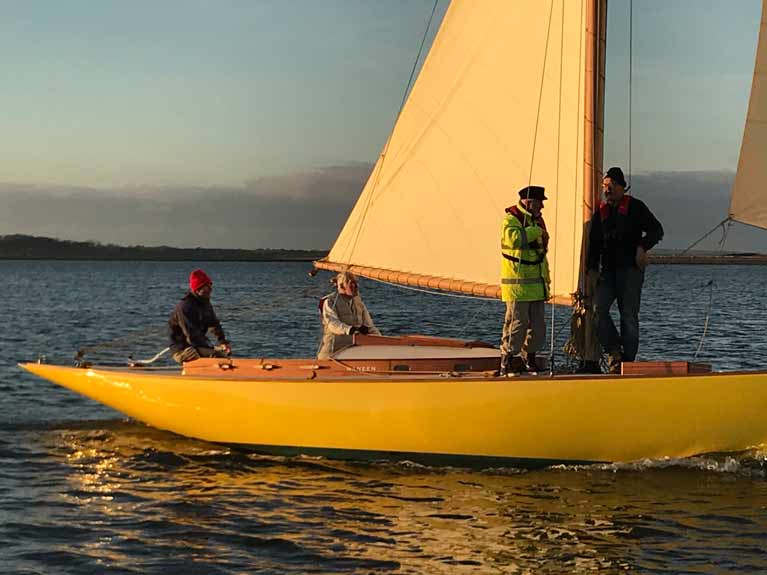 A successful Alfred Mylne design combines overall elegance with exquisite detail. The stylish cabin (which Mylne referred to as “The Den”) is a little masterpiece of coachroof design. Standing by the mast facing forward in a state of enchantment is Fionan de Barra – he sailed on Naneen in 1968 when she was owned by Willie Maguire. Photo: Kate Griffiths
A successful Alfred Mylne design combines overall elegance with exquisite detail. The stylish cabin (which Mylne referred to as “The Den”) is a little masterpiece of coachroof design. Standing by the mast facing forward in a state of enchantment is Fionan de Barra – he sailed on Naneen in 1968 when she was owned by Willie Maguire. Photo: Kate Griffiths
Getting everything just right for Naneen’s first sail began to seem like one of those projects which feel as though they’re moving ever more slowly the nearer everything gets to the final objective, particularly in the fulfilling of very special requirements for the classic-style sails Yet there was something in the air last weekend which hinted at a fair wind for all classic boat enthusiasts in Ireland, and the first sail of the Naneen on Monday was the ultimate expression of it all.
For on Saturday night, the Howth 17s had held their annual dinner and prize-giving, an event which first began 122 years ago. But 2019’s gathering – hosted by Class Captain Susan Morgan – was very special, as it celebrated the completed restoration of the class to its current full complement of 19 boats after a quarter of the fleet was variously damaged – one becoming a complete write-off – when their winter storage shed on Howth’s East Pier had its roof demolished by Storm Emma on 2nd March 2018.
But now the class is back in full health, 54 races were completed during 2019, and though the top scratch performers were Deilginis (Massey, Twomey and Kenny) and Rita (John Curley & Marcus Lynch), the class’s sensible handicap system ensures that most boats are among the silverware.
A sense of the decidedly manic mood and enhanced spirit of community which saved the Seventeens is captured in this vid by Assistant Class Captain David O’Shea
Getting the Seventeens restored to full strength has been a massive effort involving many people, and widespread and diverse craftsmen. But with a strong and supportive class organisation and several generous benefactors, it was a reasonably manageable project by comparison with the challenge of reviving the Dublin Bay 21s.
The DB21 class first raced in June 1903, with five boats competing in that opening season. Naneen didn’t appear until 1905, but she was special, as she was one of the few actually built in what was then Kingstown. Her builder was James Clancy, and the class reached what was reckoned the ideal number of seven boats with the addition of Geraldine in 1908.
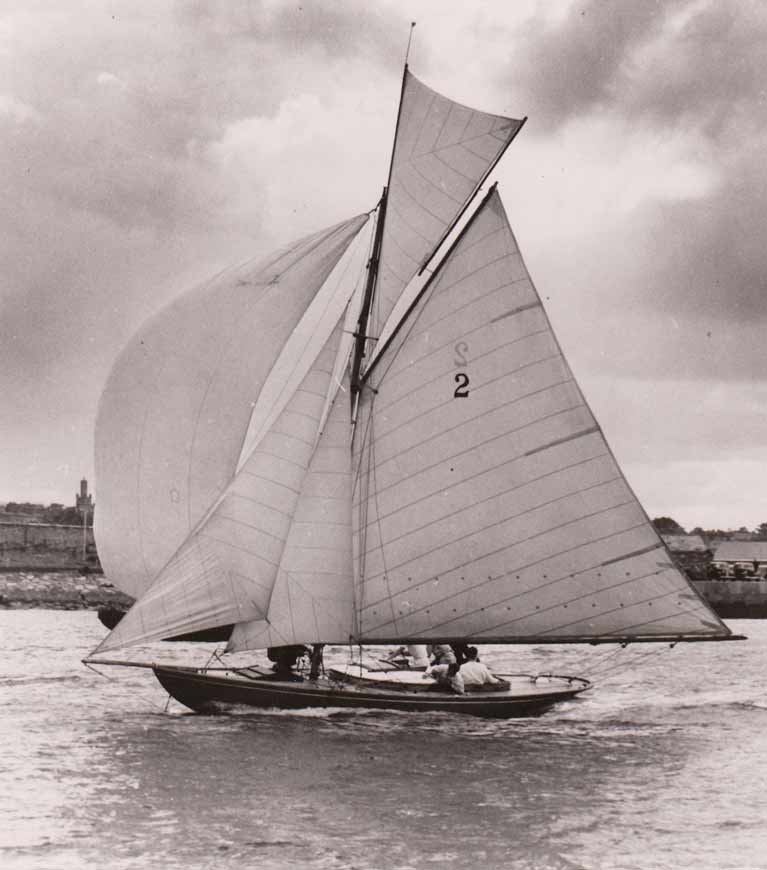 “You couldn’t see the boat for the acres of sail”. Under their original rig which they carried for fifty years, the Dublin Bay 21s were always a challenging proposition to race hard.
“You couldn’t see the boat for the acres of sail”. Under their original rig which they carried for fifty years, the Dublin Bay 21s were always a challenging proposition to race hard.
Setting a widow-making labour-intensive gaff cutter rig with a large jackyard topsail, the class became a by-word for hard-driving racing, such that by the early 1960s the hulls were becoming very tired. And crews were increasingly difficult to recruit as more easily-sailed boats in the new-fangled low-maintenance glassfibre construction came on the market.
So in 1964 the class changed to a much simpler Bermudan masthead rig. And though some reckoned the introduction of a standing backstay which was tensioned by a wheel-turned rigging screw was something which hastened the final exhaustion of the hulls, the new setup provided the class with another 22 seasons of racing.
Admittedly some of the boats were very tired indeed when Hurricane Charlie delivered the final coup de grace in Dun Laoghaire in August 1986. In those pre-marina days, the harbour became a total maelstrom, and when it finally emerged after the onshore storm feeling very bruised and battered, there wasn’t a remotely seaworthy Dublin Bay 21 left.
Most Dun Laoghaire sailors were resigned to the class’s demise, but architect Fionan de Barra was so much of a Dublin Bay 21 enthusiast that he wouldn’t hear of such a thing. Gradually he acquired the rights to all that remained of the seven 21s - whose beauty still shone through their various levels of damage – and after some time in storage in Arklow, they found a longterm home in a Wicklow farmyard while Fionan cast about for ways and means of giving them a new life.
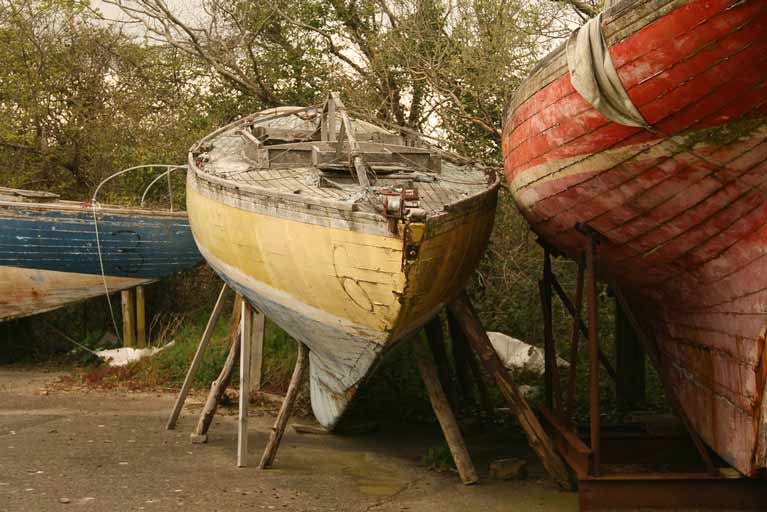 The de-commissioned Naneen with two of her sisters in a Wicklow farmyard, awaiting a restoration plan
The de-commissioned Naneen with two of her sisters in a Wicklow farmyard, awaiting a restoration plan
He’d given himself a herculean task. And when we realize that he recently celebrated his 80th birthday, we can get some notion of how he felt sailing for the first time aboard the re-born Naneen in those sublime conditions on Monday, the extraordinary achievement of his life’s most cherished dream after 33 years.
It was linking-up with Hal Sisk some years ago that really began to put the project into the realms of possibility. Hal is a veritable universe of classic yacht and boat restoration. His best-known project is the painstaking and very deservedly award-winning restoration of the 1894 G L Watson-designed 36ft cutter Peggy Bawn, which was undertaken by Michael Kennedy of Dunmore East with a small team of specialists between 2003-2005.
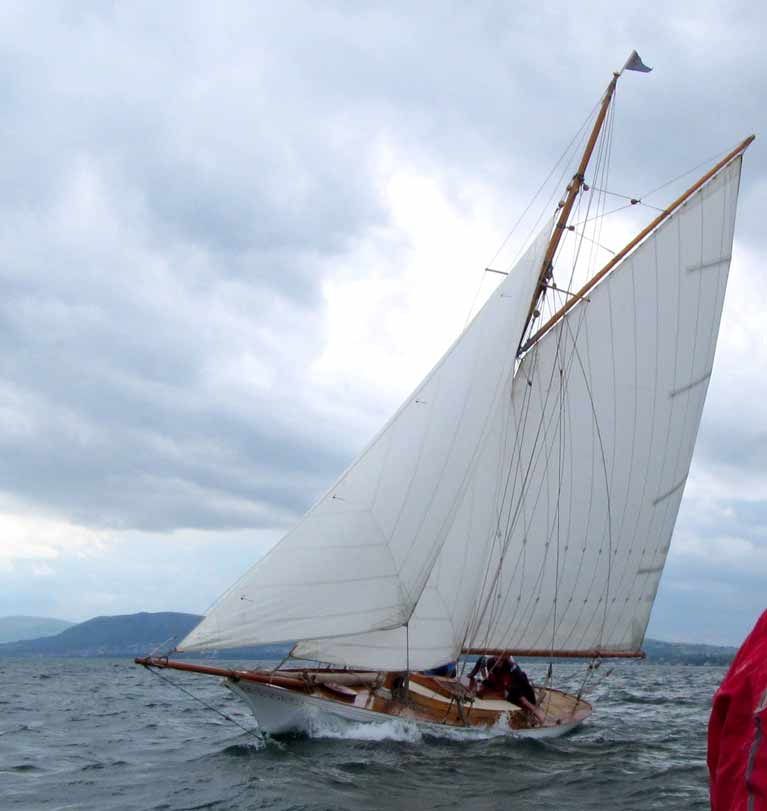 The immaculately restored G L Watson cutter Peggy Bawn sailing in Belfast Lough off Carrickfergus, where she was built by John HIlditch in 1894. Photo: Trish Nixon
The immaculately restored G L Watson cutter Peggy Bawn sailing in Belfast Lough off Carrickfergus, where she was built by John HIlditch in 1894. Photo: Trish Nixon
But before that, Hal had been a pioneer in Ireland with his restoration in 1984 of the 1884-built miniature Fife plank-on-edge cutter Vagrant. And while he has adhered to the original concept in having a new Dublin Bay Water Wag built, equally he has thought outside the box with a glassfibre version of the old Dublin Bay Colleens, which were once so popular there was an offshoot class in Argentina.
Thus Hal and Fionan began to develop ideas which retained the spirit of the class while making the boats more appropriate to the needs of today in Dun Laoghaire harbour, with its many other rival sailing attraction. They reckoned that retaining the pure Mylne-designed hull was essential, but that a simpler yet clearly vintage rig was needed for the time-constrained sailors of the 21st Century.
In the early stages of developing their thinking, they were able to draw on the fertile mind of naval architect and yacht design historian Theo Rye, who contributed so much to the Irish classic and traditional boat movement.
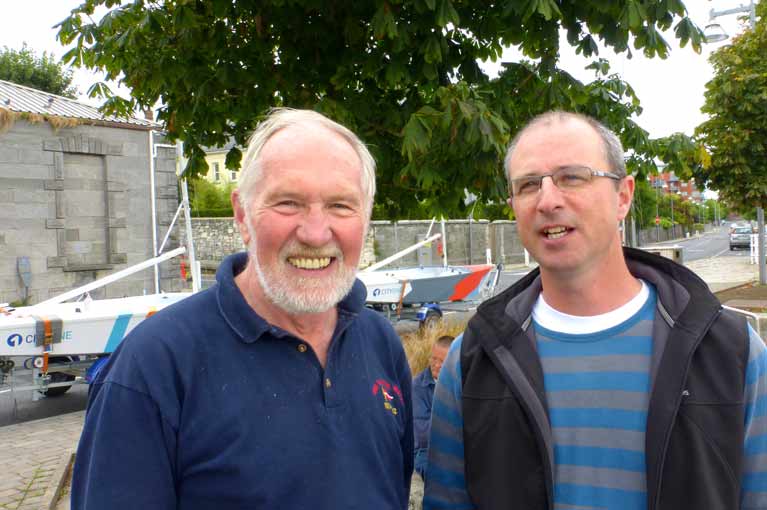 Hal Sisk and the late Theo Rye in Limerick in 2014 for the first launching of the innovative CityOne sailing dinghies (in background) which Theo designed for Gary Mac Mahon and the Ilen Boat-Building School. Photo: W M Nixon
Hal Sisk and the late Theo Rye in Limerick in 2014 for the first launching of the innovative CityOne sailing dinghies (in background) which Theo designed for Gary Mac Mahon and the Ilen Boat-Building School. Photo: W M Nixon
But very sadly he was taken from among us with his untimely death aged only 48 in 2016. The essential role of technical consultant was in due course taken on by Paul Spooner, who fully understood Hal and Fionan’s aspirations towards finding an acceptable balance between the Dublin Bay 21s’ history, and the demands of the modern sailing scene. After further research and more than a few brainstorming sessions, a plan emerged to have new timber hulls built on the original lead ballast keels – thereby continuing the direct historical line of each individual boat – but it was decided the actual boat-building would use modern wood construction technology.
Finding the appropriate specialist boatyards suitable for the task was a search in itself, and for one of the hulls, they went to England and the renowned Elephant Boatyard on the upper reaches of the River Hamble off the Solent. But for Naneen – rather special with her all-Dun Laoghaire origins – they went to Steve Morris of Kilrush Boatyard in far West Clare on the Shannon Estuary.
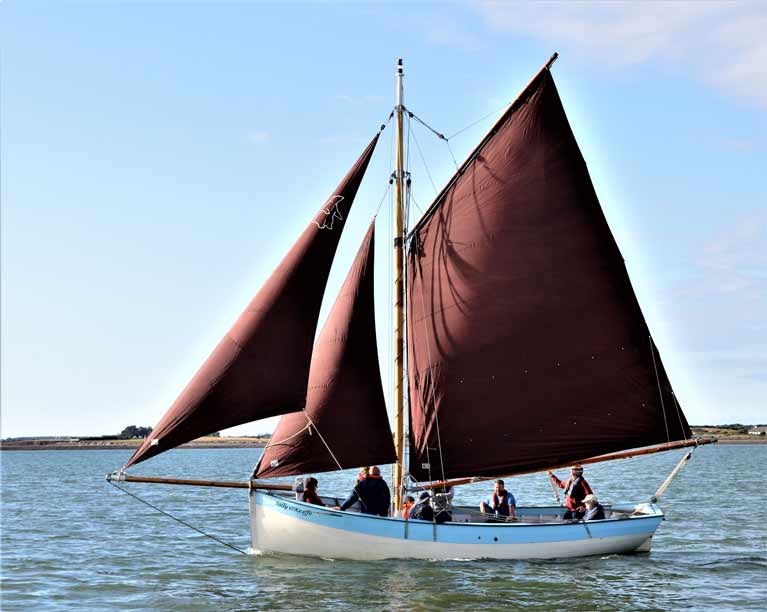 The characterful traditional Shannon cutter Sally O’Keeffe is one of Steve Morris’s best-known boat-building project
The characterful traditional Shannon cutter Sally O’Keeffe is one of Steve Morris’s best-known boat-building project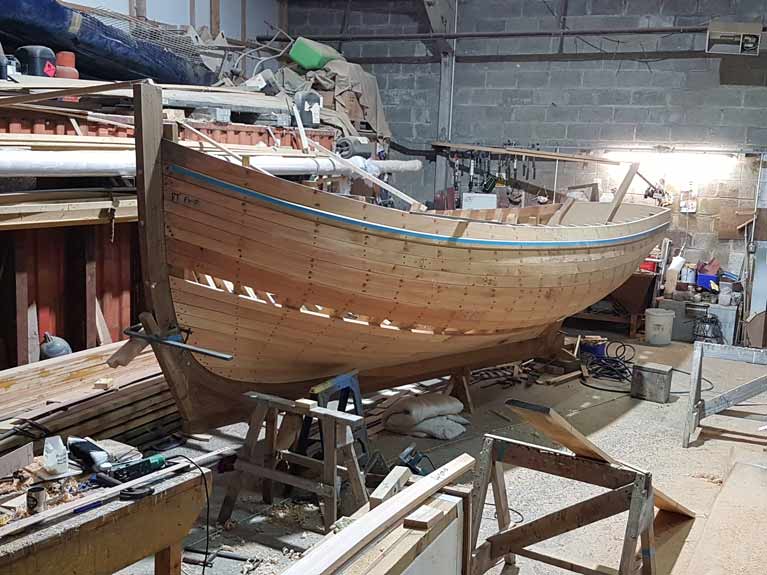 While work is continuing on two more Dublin Bay 21s in Kilrush, in another part of the big shed Steve Morris and his team are deploying more traditional boat-building skills to create this new Galway Bay gleiteog. Photo: Steve Morris
While work is continuing on two more Dublin Bay 21s in Kilrush, in another part of the big shed Steve Morris and his team are deploying more traditional boat-building skills to create this new Galway Bay gleiteog. Photo: Steve Morris
Anything that Steve Morris and his growing team undertake seems special in the quality of its workmanship, and the affable New Zealander’s abilities cover the broadest possible spectrum. Until Naneen came along, he was best known as the lead teacher-builder in the Querrin community’s creation of the Sally O’Keeffe, the utterly charming yet extremely effective re-creation of a traditional Shannon Estuary sailing working boat.
But while Sally O’Keeffe was built in the time-honoured simple planked wooden construction style, Steve has shown himself equally adept in working with the most modern materials, and the re-building of the Naneen to very clearcut standards and design requirements was a challenge he relished.
The hull was built upside-down using the SP Systems epoxy method. The main skin is 16mm yellow cedar t&g strip with two African mahogany quarter-sawn veneers on laminated African mahogany frames and ribs, with the original Alfred Mylne framing schedule being strictly followed. The entire centre-line is laminated iroko. As for the deck, in keeping with the original value concept, it is two layers of Robbins Elite marine ply on Douglas fir beams and carlins. When completed, both hull and deck were sheathed with two layers of 280 gram twill weave cloth set in epoxy.
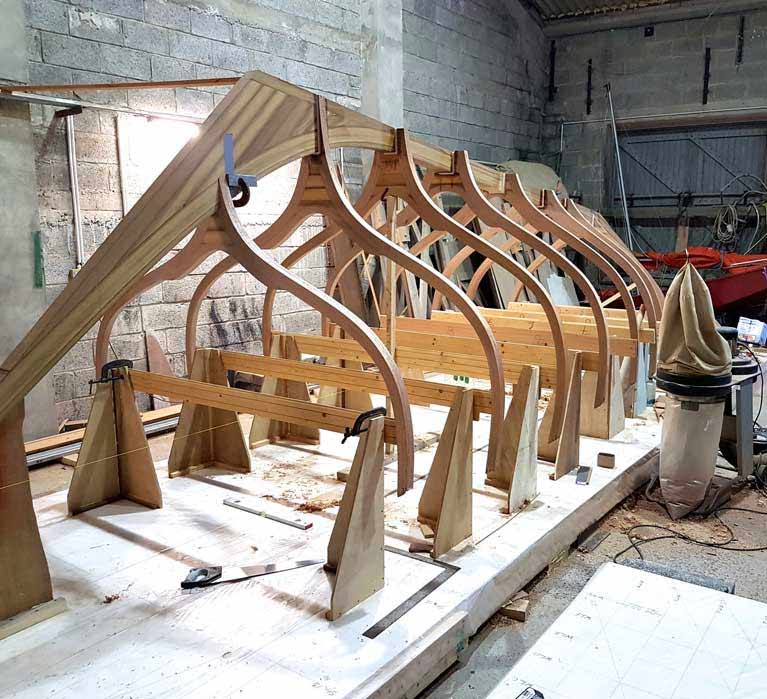 An early stage of the Naneen re-build, with the laminated African mahogany frames hinting at the classically beautiful hull which will be the finished product. Photo: Steve Morris
An early stage of the Naneen re-build, with the laminated African mahogany frames hinting at the classically beautiful hull which will be the finished product. Photo: Steve Morris
Clearly, with construction of this quality, the re-born Dublin Bay 21s are going to be in prime condition for a very long time. So it’s in line with this philosophy of the long view that the appropriate time was allocated to making the completed boat into a sailing proposition. But with a miserably wet and dark November veering inevitably into December, suddenly the weather lightened and the pace quickened, and an urgently exuberant missive from Hal this week captures the flavour of Monday’s extraordinary experience:
“We may not get such a perfect weather window before Christmas. And Naneen’s first sail was magnificent, despite being straight out of the box.
The large package with the special sails arrived by courier at home in Dun Laoghaire on Friday at 17.00, but I couldn’t get down to Kilrush until Sunday at 12 on Sunday, with three hours spent bending on the sails in a sunny calm. Then Fionán arrived down in the dark, and we stayed aboard Molly Bán (Hal’s purpose-designed motor cruiser and mothership).
Next morning, cold and clear - we’d to wait until 10.30 to even walk on the very icy marina pontoon, while Naneen's deck was straight ice. As it was completely calm we didn't expect to get out at all, so three hours hours were spent checking and fitting cleats and jib sheet fairleads and so on.
But then in early afternoon there came a light breeze. Carpe diem. Seize the day. We went out through the lock gate warped alongside Sally O’Keeffe, which would serve as photographer’s launch for Kate Griffiths if we managed to get a sail at all, and for forty magic minutes the fates were with us.
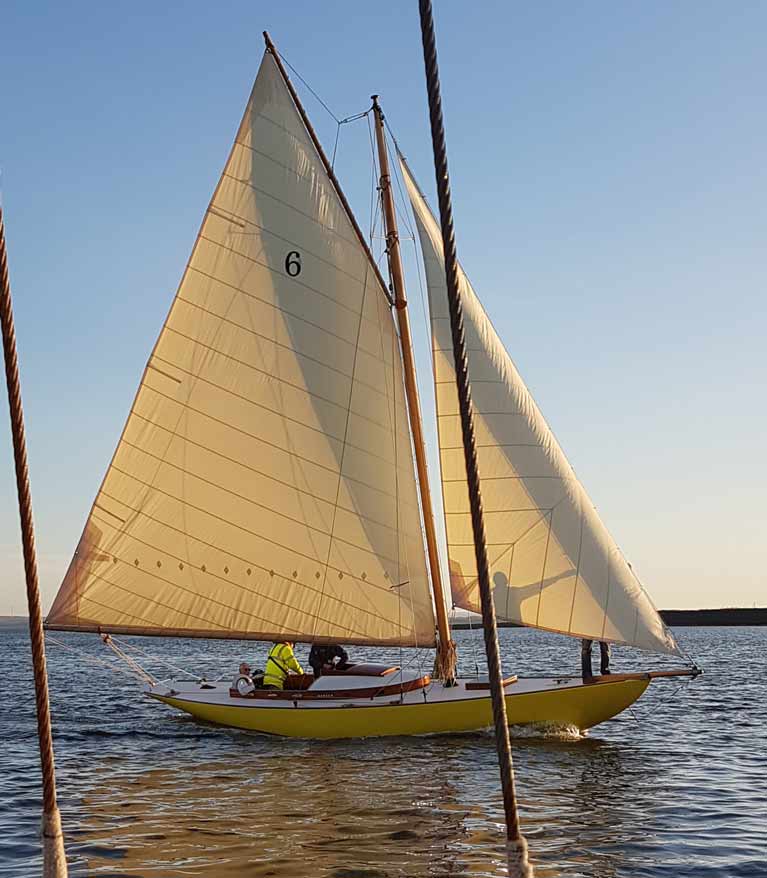 After the wettest and windiest Autumn in years, the first days of December brought ideal conditions for Naneen’s maiden sail. Photo: Kate Griffiths
After the wettest and windiest Autumn in years, the first days of December brought ideal conditions for Naneen’s maiden sail. Photo: Kate Griffiths
Everything works brilliantly! The Dyneema standing rigging (another embracing of modern materials) had been set up tight by Steve and Dan, and was just slightly slack on the lee side in an admittedly gentle wind. The breeze and late sunshine were just perfect, yielding astonishing colours – it reminded me of the time Peggy Bawn was in America, and that great photographer of classic yachts Benjamin Mendlowitz insisted we had a photo session in the evening light to make the most of Peggy’s many curves, and he was absolutely right.
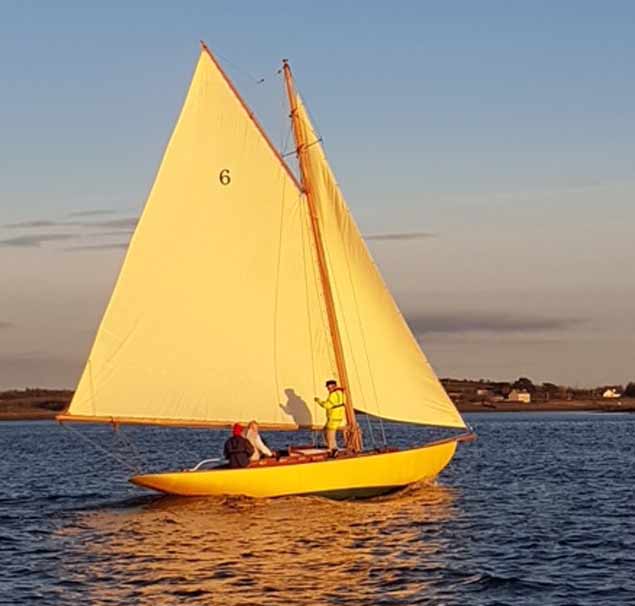 A magic weather window in December enabled the Shannon Estuary to provide a special image of the restored Naneen in classic Ben Mendlowitz style. Photo: Kate Griffiths
A magic weather window in December enabled the Shannon Estuary to provide a special image of the restored Naneen in classic Ben Mendlowitz style. Photo: Kate Griffiths
Naneen slipped along so effortlessly, leaving little wake, that at times it was all that Fintan could do to keep up with us with Sally O’Keeffe under power. Enchantment was total. All credit to the wonderful work of Steve Morris, Dan Mill, James Madigan, Fintan Carroll, and Kate Griffiths. And also Sue Pennison for the splendid rope and leatherwork, while on the day a special mention for Steve Hall of North Sea Sails of Tollesbury.”
 Key members of the Naneen restoration team at her launching at Kilrush in September included (left to right) Steve Morris, James Madigan, Hal Sisk, Fionan de Barrra, Fintan Ryan and Dan Mill. Photo: W M Nixon
Key members of the Naneen restoration team at her launching at Kilrush in September included (left to right) Steve Morris, James Madigan, Hal Sisk, Fionan de Barrra, Fintan Ryan and Dan Mill. Photo: W M Nixon
The new look for the Dublin Bay 21s makes us realise that in their original form, the huge rig was such an in-your-face feature that you scarcely noticed the remarkable and harmonious beauty of the hull and coachroof. But now with the simpler rig they’re there for full appreciation, and by next summer the first four restored boats should be in Dun Laoghaire and available for accessible sailing.
Their presence will fit well with the developing quest to provide a more meaningful interaction between town and harbour, but meanwhile, the growing size and vigour of the classic Dublin Bay Water Wag class is testament to the eternal attraction of wooden boats to time-honoured designs. For although today’s 14ft 3in Wags - as designed by Maimie Doyle in 1900 - may have seen as many as sixty boats built over the intervening 119 years, until recently there had always been a certain level of attrition, and when boats disappeared beyond trace, the class was scrupulous abut re-allocating their sail numbers to new boats, rather than allowing an artificial total to develop.
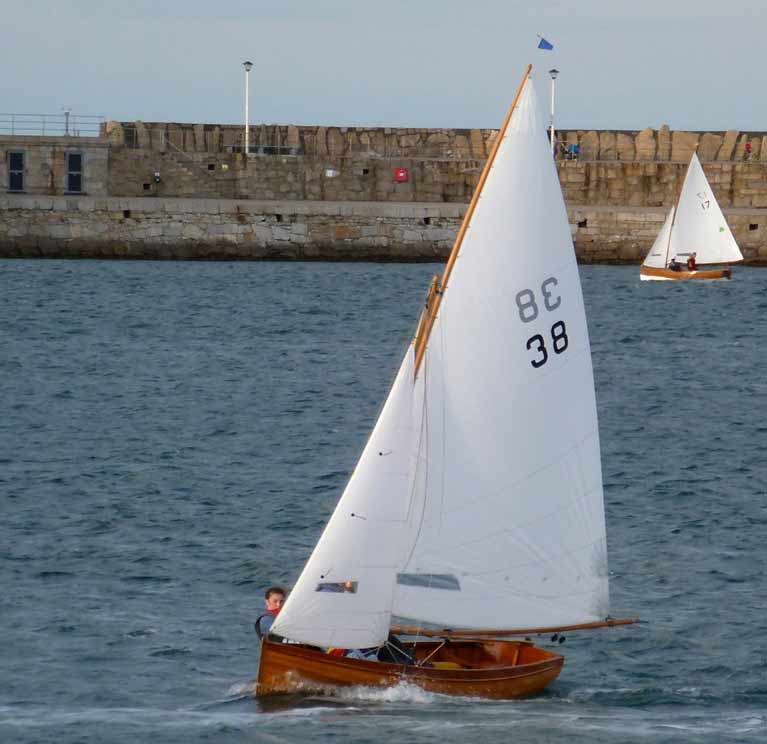 Guy Kilroy’s 2001-built Water Wag Swift in top racing trim. In 2020 the class – established in 1887 - will have more than fifty registered boats to the Maimie Doyle design of 1900. Photo: W M Nixon
Guy Kilroy’s 2001-built Water Wag Swift in top racing trim. In 2020 the class – established in 1887 - will have more than fifty registered boats to the Maimie Doyle design of 1900. Photo: W M Nixon
But 2020 will be special, as an officially registered Water Wag No 50 will be sailing for the first time ever, owned by Mandy Chambers and created under a Boat Building School scheme at the Albola yard in San Sebastian in the Basque region of Spain. There, another interesting project is the re-creation of a very ancient Basque whaler found in the St Lawrence river in Canada, which may be proof – were it needed – that enterprising Basque fishermen were well aware of the existence of North America before Columbus got there, but had kept it as a trade secret.
The reach of the vintage Irish one design classes has also extended across the Atlantic, as a Water Wag for David Espey and a Dublin Bay 24 are both being created in the Apprenticeshop in Rockland in Maine, while of course in France, Mike Newmeyer’s Skol ar Mor near the Morbihan has availed of the Water Wag, Shannon One Design and Howth 17 boat-building ambitions to keep school programmes busy, as has Paul Robert’s Les Ateliers de L’Enfer in Douarnenez, where Ian Malcolm organised the re-building of the fatally-damaged Howth 17 Anita under the classic boat principle that’s it’s a re-building of the same boat if you use the original ballast keel.
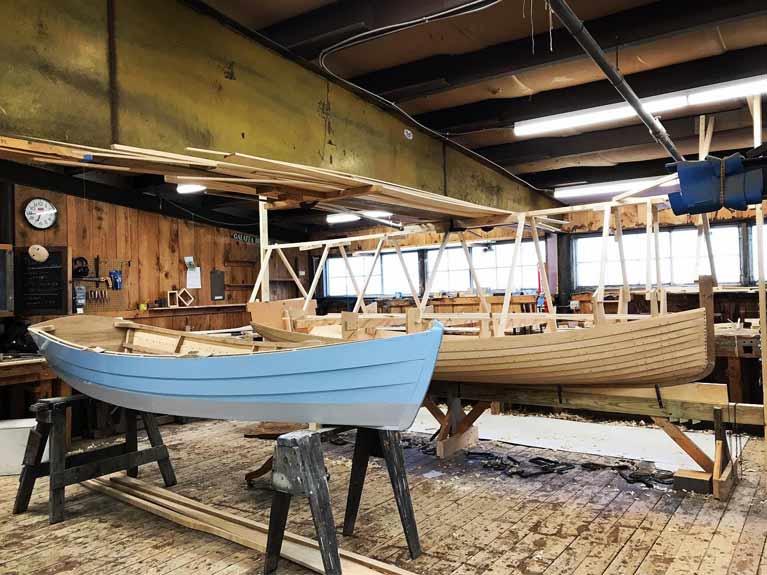 A new Water Wag for David Espey of Dun Laoghaire under construction (right) in the pleasant surroundings of the Apprenticeshop in Maine.
A new Water Wag for David Espey of Dun Laoghaire under construction (right) in the pleasant surroundings of the Apprenticeshop in Maine.
This utilisation of state-subsidised Boat Building Schools in France and Spain has been a Godsend for Ireland’s classics, but even though state support – if any – is extremely limited in this country and would be on a case-by-case basis through local authorities, it’s refreshing to find that craftsmen based in Ireland can rise to the challenge if given the chance.
Admittedly both Steve Morris and his expert team-mate Dan Mill of Galway hail from New Zealand, while Rui Ferreira down in Ballydehob – ace builder of Water Wags who is also currently putting a new deck on his second Howth 17 – is from Portugal. But the restoration of the Howth 17s to their pre-Storm Emma strength and better has found an encouraging level of traditional boat-building expertise hidden away in Leinster.
Brendan Tracy of Arklow – who worked on the restoration of Hal Sisk’s little 1884 Fife cutter Vagrant way back in 1984 – is still going strong, and after Storm Emma he put a new stem and other significant repairs into Michael and Jane Duffy’s Hera, one of the original five 1898 Howth 17s. And it was of course Larry Archer of Malahide, working in a shed out the back of the airport, who managed to find the time to restore Davy Jones and George Curley’s mega-damaged 1907-vintage Seventeen Rosemary, while at the same time making a very effective job of bringing Guy and Jacky Kilroy’s 25ft cutter Marguerite – built by Jack Wellington in Malahide in 1896 – up to a new standard of classic quality
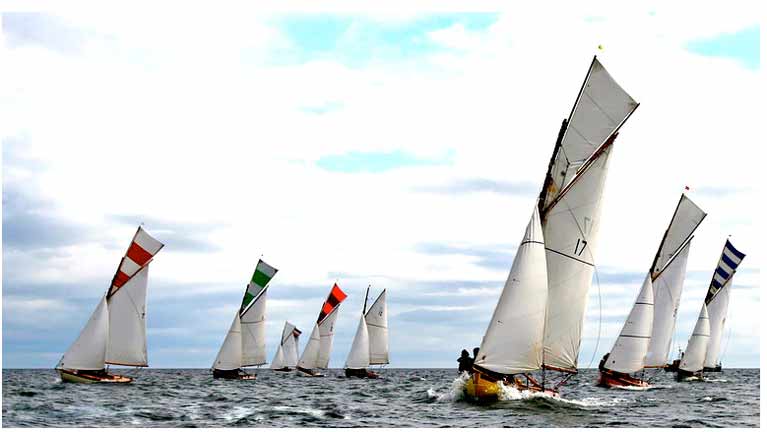 The 122-year-old Howth 17s marked the return to their full strength of 19 boats at their Annual Dinner and Prizegiving last weekend after successful restoration projects following the depredations of Storm Emma in March 2018. Photo: John Deane
The 122-year-old Howth 17s marked the return to their full strength of 19 boats at their Annual Dinner and Prizegiving last weekend after successful restoration projects following the depredations of Storm Emma in March 2018. Photo: John Deane
Inevitably links to West Cork seem to emerge wherever you turn in our classic and traditional boat-building, and there’ll often be someone from the widespread Leonard clan involved, as was seen when Gerry Levins and Mick Leonard in Portmarnock made good some fire damage on Shane O’Doherty’s Howth 17 Pauline. So with other wooden boatbuilders such as Tiernan Roe of Ballydehob adding to the talent pool, all roads seem ultimately to lead to Oldcourt on the Ilen River above Baltimore, where Liam Hegarty made such a masterful job of bring the 56ft 1926 ketch Ilen back to life, and the current project is the re-building of the one and only Saoirse.
But for now, the focus of attention is the re-born Naneen. Her luminous maiden sail in the early days of December means Christmas has come early for classic boat enthusiasts throughout Ireland.
“Stars Wars: The Last Frontier” The New Name for Kerry Coast?
It is ironic that the internationally-recognised abbreviated sail number identification on Irish racing boats should be IRL writes W M Nixon. For in global tech-speak, IRL is the acronym of “In Real Life”. If the rather intriguing way of existence we have in Ireland these days truly is Real Life, then all we can say is fasten your seat belts, put on the goggles, and be prepared to believe anything at least once.
Nowadays, our senses are so assaulted by hugely sophisticated electronic data that it can be difficult, if not impossible, to say where reality ends and artificiality begins. And in any case, the signals which the various human sensors are transmitting have to go though so many conduits before they reach the brain and the processing therein, that you could be forgiven for thinking that an extra layer or two in the out-of-body world can’t really make all that much difference.
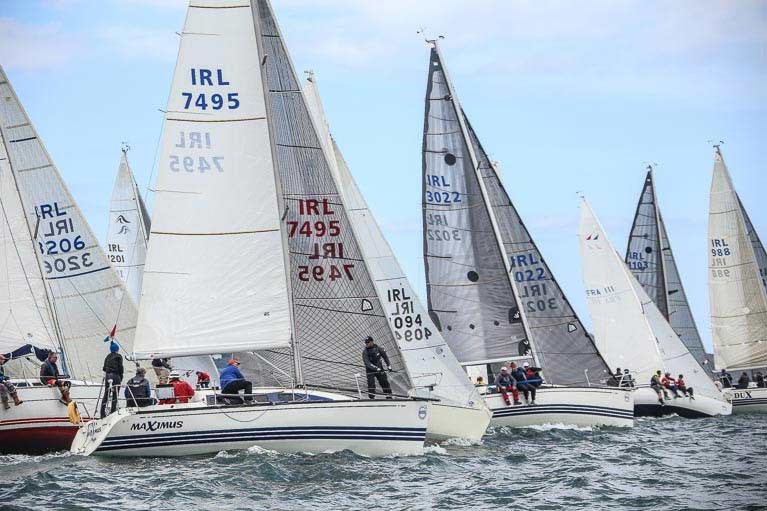 Now you see it, now you don’t – these competitors in the ICRA Nationals 2019 at the RStGYC in June are actually celebrating their participation In Real Life. Photo: Afloat.ie/David O’Brien
Now you see it, now you don’t – these competitors in the ICRA Nationals 2019 at the RStGYC in June are actually celebrating their participation In Real Life. Photo: Afloat.ie/David O’Brien
Thus it could well be that the categorizing of anything as being In Real Life is a shrinking area. If we haven’t seen it on screen or experienced it through other Virtual Reality devices, then we don’t believe it. And what you see on screen can be whatever those who are screening wish it to be.
These meandering thoughts are prompted by the rumour from down Kerry way (where rumour is reality) that the association of the magnificent sea rock monastery of Skellig Michael with the Star Wars movie franchise has been so successful in promoting local tourism that there’s a move afoot to rename the entire and utterly sublime Kerry coast as “Star Wars’ Last Frontier”.
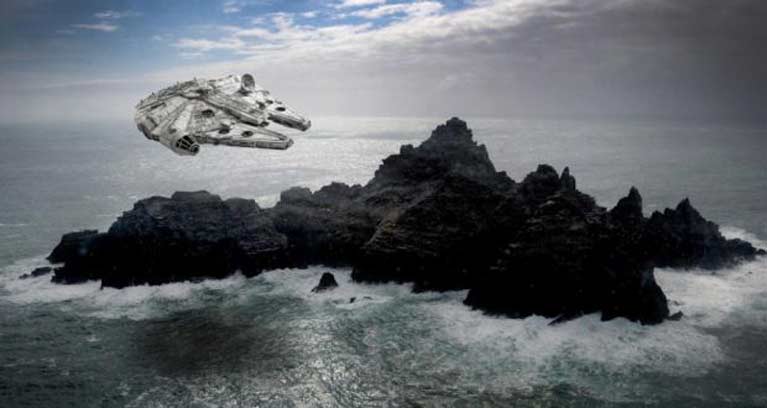 The Star Wars fighter/freighter flies past the Little Skellig on the way to land people and cargo on Skellig MichaelDoubtless, it emanates from Kilgarvan, which isn’t even on the coast, but this hasn’t stopped that mountainy village from producing some of the most off-the-wall ideas in Irish public life. So what are those of us, for whom Skellig Michael and the coast inside it have such special sailing associations, going to think? What are we to make of its possible re-packaging as something which is basically totally imaginary as part of an international entertainment brand?
The Star Wars fighter/freighter flies past the Little Skellig on the way to land people and cargo on Skellig MichaelDoubtless, it emanates from Kilgarvan, which isn’t even on the coast, but this hasn’t stopped that mountainy village from producing some of the most off-the-wall ideas in Irish public life. So what are those of us, for whom Skellig Michael and the coast inside it have such special sailing associations, going to think? What are we to make of its possible re-packaging as something which is basically totally imaginary as part of an international entertainment brand?
For branding is what it’s all about. Those of us who have known and loved Ireland’s Atlantic seaboard, both by sea and land, for decades had distinctly mixed feelings about its re-branding as the Wild Atlantic Way. Certainly it’s a snappy little phrase, but snappy little phrases seem like something in questionable taste in attempting to capture the magnificence of this majestic coastline.
Yet as that great showman P T Barnum so pithily put it, “Nobody ever went broke by under-estimating public taste.” To say that the Wild Atlantic Way has been a marketing success is like saying that the Eiffel Tower is a tall and conspicuous iron structure. It has been pure marketing genius. And inevitably the marketing power of the Wild Atlantic Way has brought the problems of success, such that lovers of the Atlantic coast in unsullied form can only console themselves with the thought that many of the roads are so blessedly small that the inevitable tour buses cannot negotiate them.
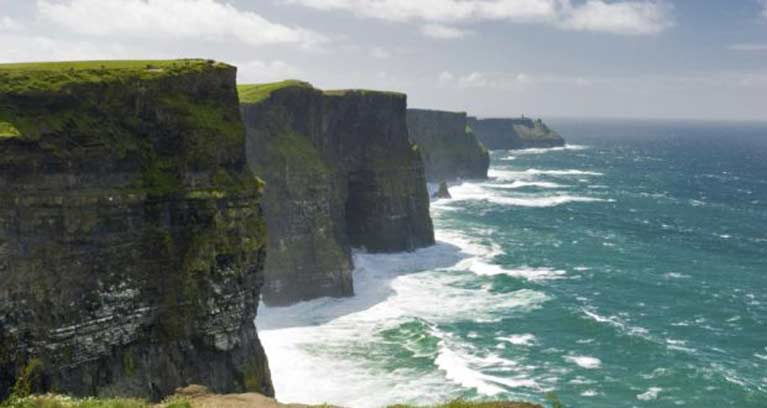 Eternally magnificent in their raw state, but the Cliffs of Moher have become so packaged these days as to be almost institutionalised
Eternally magnificent in their raw state, but the Cliffs of Moher have become so packaged these days as to be almost institutionalised
Thus the visiting groups tend to be bussed to the more accessible places in such crowds as to spoil them, so much so that if you were anywhere near the Cliffs of Moher because your will to live is in some doubt, don’t worry about the uncertainty - the scene at the cliffs and its Visitor Centre and bus and car parks will soon make you genuinely suicidal.
Others react to this Wild Atlantic Way thing in a more positive style. A recent posting on the ketch Ilen site by Gary Mac Mahon of the Ilen Project in Limerick shows a photo of Conor O’Brien at the helm of the ketch Kelpie off Ireland’s west coast in 1913, and the Sage of Shannonside describes it as being a time when this was the “Wild Authentic Way”, which is neat.
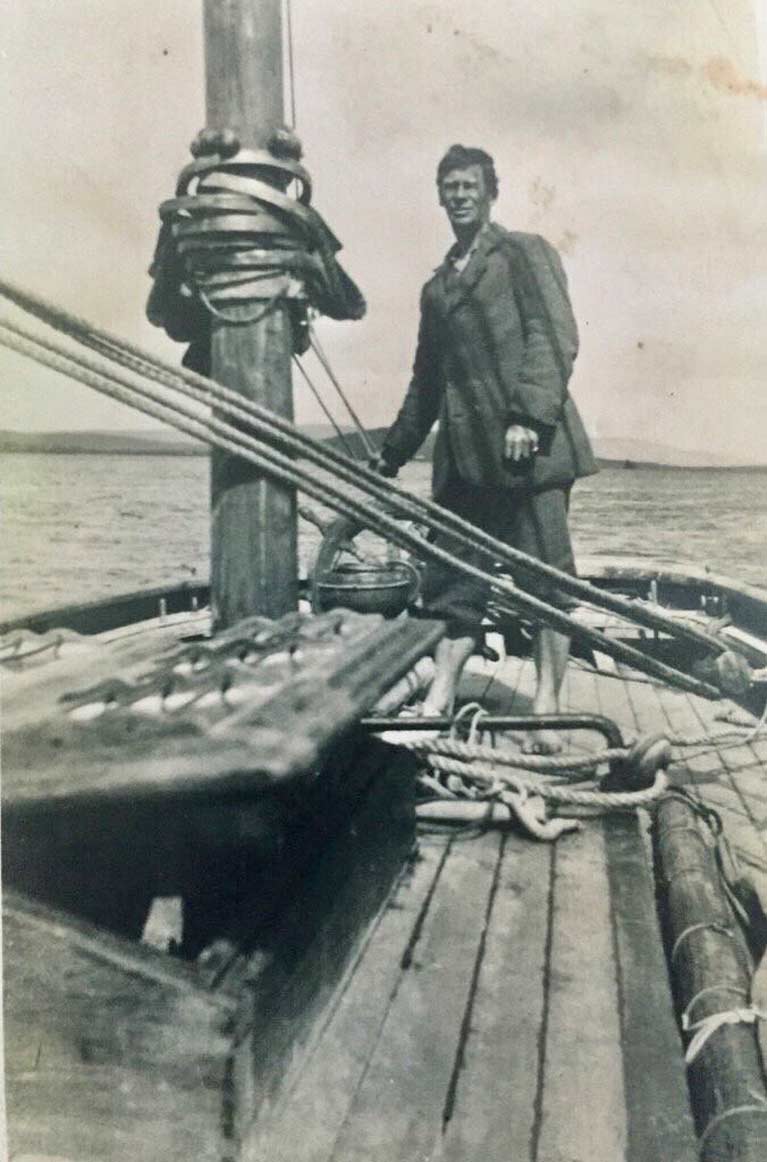 Conor O’Brien of Foynes Island at the helm of his ketch Kelpie off the West Coast of Ireland in 1913 when it was still the “Wild Authentic Way” Photo courtesy Gary Mac Mahon
Conor O’Brien of Foynes Island at the helm of his ketch Kelpie off the West Coast of Ireland in 1913 when it was still the “Wild Authentic Way” Photo courtesy Gary Mac Mahon
Yet the re-branders persist in going about their work for all Ireland, and for some time they’ve been trying to get us to think of a particular area as The Ancient East, which immediately projects an image of a ruinous and overgrown region inhabited almost entirely by dribbling geriatrics. This may indeed be how the rest of Ireland likes to see us, but if the marketing wonks simply called it Leinster and encouraged the rugby team to keep winning, it would surely do much more good.
The biggest problem in terms of a snappy marketing phrase continues to be the Midlands. Those of us of a boat-minded persuasion are more than happy to think of it as the Shannon and its lakes, but maybe the difficulty is that the international perception of the word “Shannon” is of an airport where old-style Russian leaders used to sleep off an excess of drink, a place where there are secretive comings and goings of enormous and minimally-marked aircraft under cover of darkness. Definitely not an image one wishes to associate with a cherished holiday area.
Be that as it may, although Kerry is one of the biggest jewels in the crown which is the Wild Atlantic Way, being the Kingdom of Kerry (which is how it sees itself despite being up to the eyeballs with republicanism), it wants to reassert its own identity, and it seems that Star Wars Last Frontier is a front runner in the re-naming stakes.
It’s just grand, but where’s the reality of the Kerry coast in all this?
Not to worry. They can call it whatever they like, but it’s still the real deal under any name for those of us who have been sailing it for longer than we care to remember.
The first time was very well back in the previous Millennium when we slugged our way southward from Inishbofin off the Galway coast in the ancient yawl Ainmara, and after a night or two at sea found ourselves in Brandon Bay in Kerry, anchored off the hospitably little settlement of Brandon itself. It was a place well furnished for hospitality with three pubs, in one of which we had an enormous feed while swilling pints and watching the new television channel with Dev himself making a very prescient broadcast about the perils of this mysterious medium.
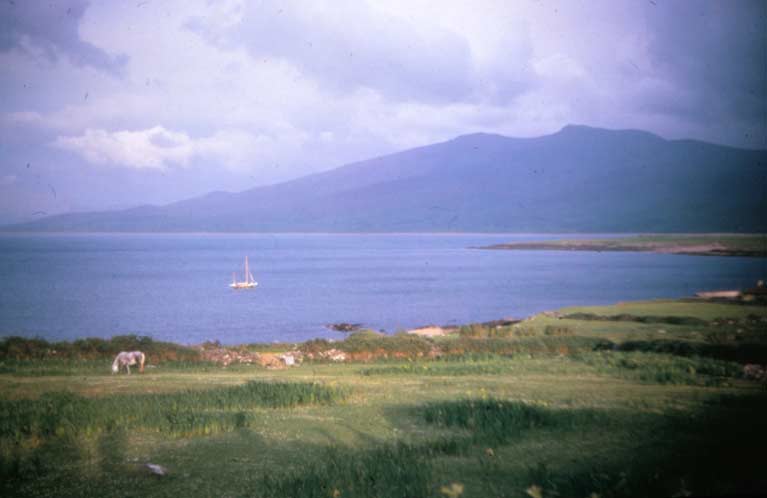 First impressions of Kerry. Ainmara in Brandon Bay a long time ago, having sailed mostly to windward, and at one stage through a summer gale, from Inishbofin off West Connemara. Photo: W M Nixon
First impressions of Kerry. Ainmara in Brandon Bay a long time ago, having sailed mostly to windward, and at one stage through a summer gale, from Inishbofin off West Connemara. Photo: W M Nixon
Whether you come along the coast from north or south, Kerry makes an indelible impression, and coming from the south the effect is heightened if you make your entrance through Dursey Sound under the creaking cable car. Emerging on the north side of the Sound, the entire glorious panorama of the Kerry coast is spread out across the horizon, from the Bull Island, the Blasket and the Skelligs to the west, right round to the rising purple heights of McGillycuddy’s Reeks (it’s easier to say it as “Mackle-cuddy” even if that’s not entirely correct) as they soar towards the peaks about Carrantuohill to the east.
Under these many hills and mountains are enough inlets and anchorages and harbours and inshore islands to interest you for a week or a fortnight, the magic of it summed up in names like Ventry, Dingle, Cromane, Kells Bay, Knightstown, Cahirsiveen, Ballinskelligs, Derrynane, Sneem, Parknasilla, Dunkerrin, Kilmakilloge, and Ardgroom with many others.
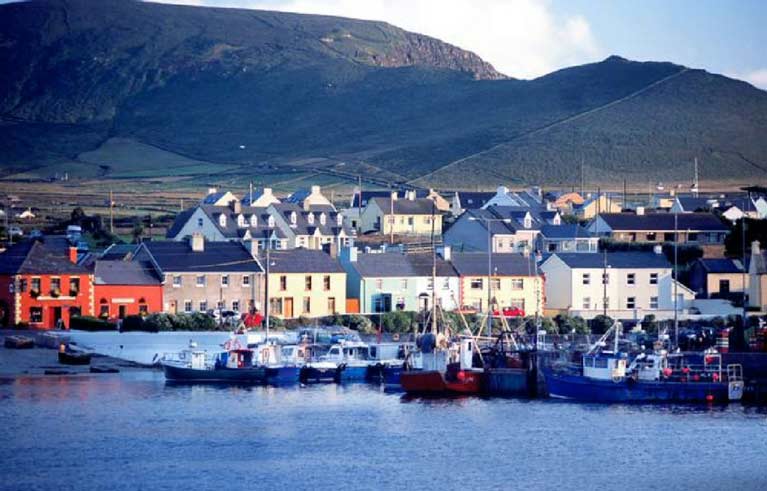 Portmagee on the mainland side of the south end of Valentia Sound is now seen as Port Star Wars
Portmagee on the mainland side of the south end of Valentia Sound is now seen as Port Star Wars
And there in the midst of them is Portmagee, which has reinvented itself as Port Star Wars, providing the quickest access to Skellig Michael. It’s the reality of modern life that the place is thriving because of its association with a contemporary sci-fi film series. And those who would be inclined to sniff at such a thing would do well to remember that they may be of a generation which first became most vividly aware of the special magic of Skellig Michael because it featured in Kenneth Clark’s classic 1969 TV series Civilisation, its extraordinary history as a remote island mini-monastery being featured, for its isolation meant it survived as an outpost of civilization while the rest of Europe was plunged for a century into the horrors of the Dark Ages.
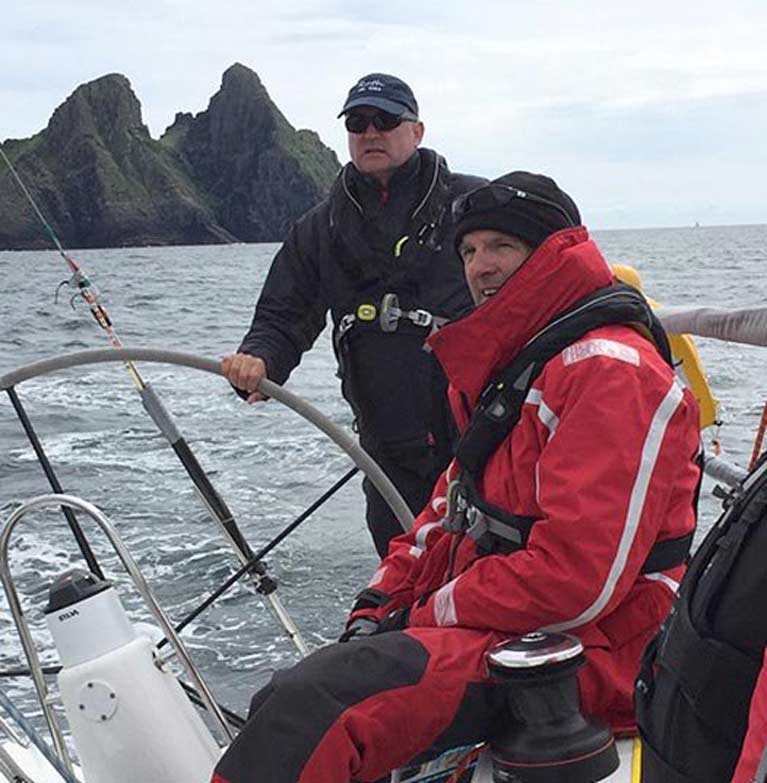 One of the most special moments in Irish offshore racing. Liam Shanahan helming the 2015 Dun Laoghaire to Dingle Race winner Ruth with the Great Skellig put astern.
One of the most special moments in Irish offshore racing. Liam Shanahan helming the 2015 Dun Laoghaire to Dingle Race winner Ruth with the Great Skellig put astern.
For most of today’s sailors, Skellig Michael rears its handsome head every second year as the final turning point in the Dun Laoghaire to Dingle Race. In fact, the turning point is a waypoint to the west of the Skellig which is supposed to keep contestants safely clear of the Washerwoman Rock to the southwest of the Skellig, whose breakers are clearly visible in our header photo.
But in the 2017 race when the fleet were beating from the Fastnet to this turn, one boat which had better remain anonymous was doing very well by energetically tacking along the mainland shore, and they only came out to the Skellig waypoint turn at the last possible minute, which meant the tracker showed that they sailed through the gap between the Skellig and the Washerwoman, yet still complied with the requirement to leave the waypoint to starboard. You know who you are……..
Racing round the Skellig is better than not seeing it at all. But a leisurely visit ashore was best of all if, during a cruise in the area, the weather happened to be exceptionally settled and the ocean relatively swell-free. We’re talking of times past before the development of the current regulated visiting system, though doubtless a cruising man or woman with the golden tongue could talk their way ashore as being successors to the Irish voyaging monks of the early Middle Ages, a line we successfully took when getting onto the very attractive monastery island of Caldy off southwest Wales many years ago.
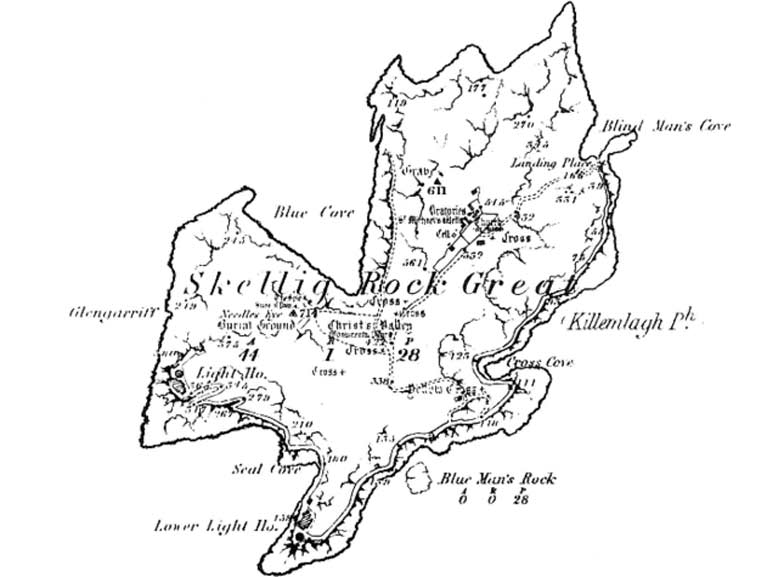 Map of Skellig Michael. The most sheltered landing place is at Blind Man’s Cove at the northern end.
Map of Skellig Michael. The most sheltered landing place is at Blind Man’s Cove at the northern end.
Our visit to Skellig Michael was back in 1982, when things were very relaxed. The first Star Wars film had only been made eight years earlier, and any idea of associating the natural drama of Skellig Michael with the series was still many years in the future, so we were able to enjoy Skellig Michael in its last years of innocence with a certain air of unreality.
In fact, there was something unreal about that entire cruise, which was round Ireland anti-clockwise in the Hustler 30 Turtle in conditions so summery that we had our first transit of the Joyce Sound Pass inside Slyne Head, coming from the westward as though going through the Grand Canal in the midst of Kildare. Later we spent some leisurely time on the Great Blasket Island before overnighting in Knightstown on Valentia, then waking there early in the morning to an even more perfect day with a gently fading easterly, which allowed us to run under spinnaker out to the Skellig.
There, the wind obligingly fell away to enable an easy landing of two of the crew while the third reversed Turtle away from the island quay to await his turn to land later. But nearby, our friend Larry Swan from Galway with just his son aboard Finola was so determined that they should go ashore together that they anchored right under the cliff in 25 fathoms and made the joint visit which they thought well worthwhile, even if it did take them an hour and ten minutes to retrieve their ground tackle afterwards.
Subsequently, we learned that another cruising boats with whom we’d been socialising with some energy in Knightstown had taken so long to emerge into the new day that it was well into the evening by the time they got to the Skelligs. The day’s ferry schedule was long completed, there were no other cruising boats seeking to land, and they’d the luxury of having the landing place in Blind Man’s Cove to themselves for a quiet visit as the sun set.
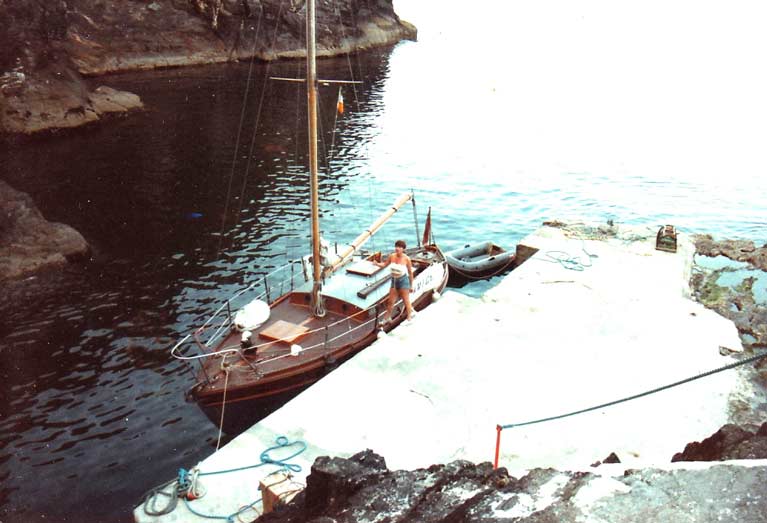 The height of luxury – on a very rare calm evening, you can have the Skelligs landing at Blind Man’s Cove to yourself, or at least you could before Star Wars came along.
The height of luxury – on a very rare calm evening, you can have the Skelligs landing at Blind Man’s Cove to yourself, or at least you could before Star Wars came along.
While we were there, at the landing place and around the steep sea mountain itself there was something of a regatta atmosphere - not over-crowded with those who had come over from Portmagee via the launch service, yet with enough people for interesting variety, ranging from those who were clearly on a personal pilgrimage, to a group of athletic and sun-tanned young German women who were out-doing each other in the skimpy bikini stakes. Skellig Michael at that time could absorb it all, and it really is one of those places which exceed all expectation when you finally get there.
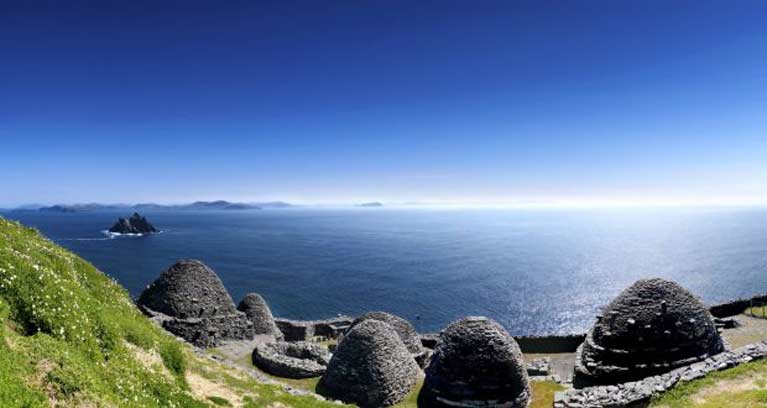 A totally other-worldly place – the beehive stone huts of the miniature monastery on Skellig Michael high above the Atlantic.
A totally other-worldly place – the beehive stone huts of the miniature monastery on Skellig Michael high above the Atlantic.
Unfortunately these days too many people want to do that, so we cherish our memories of Skellig Michael, and while two of us found even the little monastery with its distinctive stone beehive huts almost too vertiginous, our third shipmate was immune to heights, and he crossed Christ’s Saddle to the hermitage on the highest point.
There he found the legendary Mr Murphy the stonemason and conservationist from Valentia, who spent each summer on the island on maintenance projects and went about his work at dizzying heights with quiet unconcern so that sometimes he seemed to hover like a hummingbird with such effortless ease with no visible support that our shipmate, in returning across the Saddle, was so inspired by what he’d seen Mr Murphy do that he almost fell off. But he’d the thoughtfulness not to tell us this for a day or two.
For contrast, we headed on to the anchorage of Derrynane and the abiding presence of Daniel O’Connell and Conor O’Brien and Lord Dunraven and all those other Derrynane summer people of times past, and finally after a last Kerry anchorage in the hidden natural harbour of Cleanderry (the entrance is only 25ft wide), we bade farewell to what may well become the Star Wars Coast and sailed south to windward through Dursey Sound with some very short tacks, and headed on to the delights of West Cork.
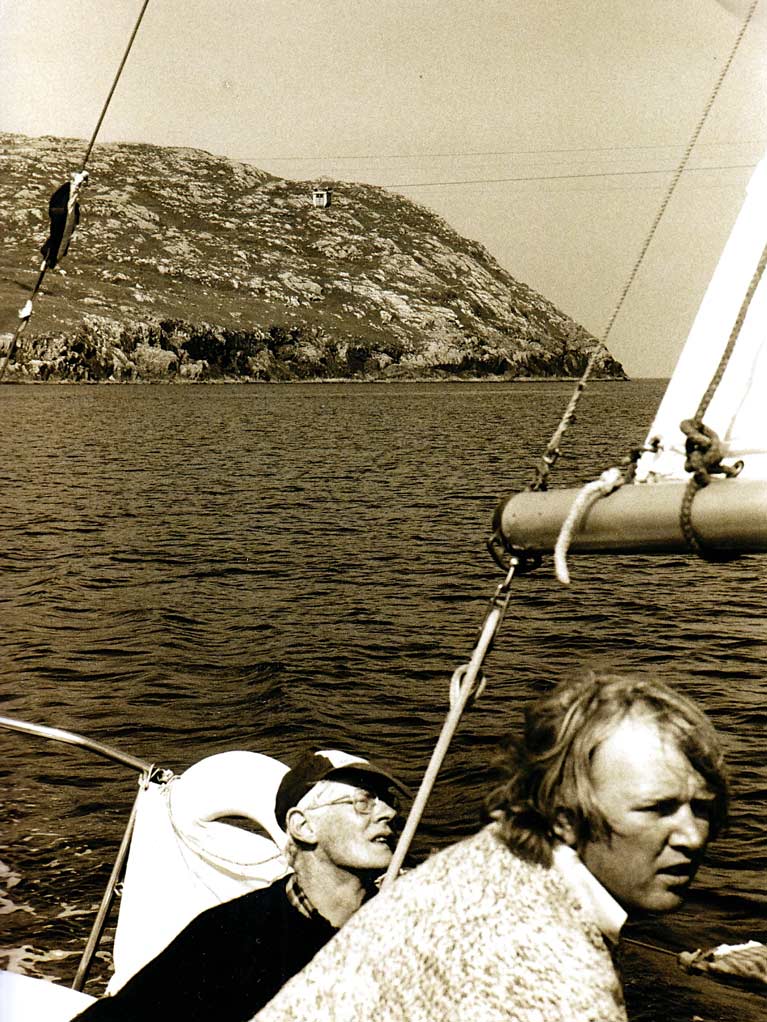 Departure from the Kerry coast – tacking southward through Dursey Sound on Turtle, with the cable car creaking its way across overhead, while the late Brendan Cassidy concentrates on getting the best windward performance, and Johnny Malcolm wonders if we aren’t getting a bit too near the mainland coast of Beara. Photo: W M Nixon
Departure from the Kerry coast – tacking southward through Dursey Sound on Turtle, with the cable car creaking its way across overhead, while the late Brendan Cassidy concentrates on getting the best windward performance, and Johnny Malcolm wonders if we aren’t getting a bit too near the mainland coast of Beara. Photo: W M Nixon
So would a re-branding of the Kerry seaboard as the Star Wars Coast, and thus something extra-special within the Wild Atlantic Way marketing project, be beneficial in the long run? The jury is surely out on that. But you can sympathise with the people of Kerry in trying to use names from elsewhere for their benefit. After all, does Kerry benefit in any special way from the quintessential Irish product being called Kerrygold? And apparently, it has been ruled in some court or other that “Kerry” is such a generic name that people are free to use it for products regardless of where they are produced in Ireland, or indeed anywhere in the world for all we know.
But the “Star Wars’ Coast”? Would that work IRL – In Real Life? Perhaps. But not as we know it, Jim….
Ireland’s 'Bantry Boats' – Complex Heritage Creates Historic Gems For Lough Neagh this Summer
Most sailing folk in Ireland will have some level of awareness of the Bantry Boat. Even those who live most determinedly in the present, and look unswervingly to the future, will be vaguely aware that thanks to some fortuitous turns of history, on both sides of the Atlantic we now have flotillas or individual examples of sailing/rowing craft of a classic design which is pushing towards being 250 years old and more in its origins. Old they may be in concept, yet these boats provide a valid combination of rowing and sailing for seamanship and adventure training which has a special resonance today, and in coastal communities, they can be a focal point for active maritime involvement writes W M Nixon.
The ship’s gigs of the 18th Century were a reflection of the vessels they served. One of the best-known of them, the longboat in which Captain Bligh made his astonishing 3,500 mile voyage in 1789 in the Pacific after being set adrift by Fletcher Christian and his fellow-mutineers, was a modest 25-footer which was in keeping with the fact that her mother-ship the Bounty was an ordinary workaday ship just 90ft long.
But the longboat which was left behind on Bere Island after the failed French invasion of Bantry Bay by 43 ships in 1796 was all of 38ft long. For this was the proper 1790-built Admiral’s Gig of a flagship of the Revolutionary Navy, and in size and style she showed the important status of the ship and officers she served.
The slim and elegant service vessel’s abandonment in that rugged part of the world where West Cork is verging into Kerry was ultimately the saving of her, for in time she was taken into the boathouse in Bantry House. And that fortuitous place of shelter was the perfect preservation pod - neither too warm nor too cold, neither too dry nor too damp. Over the years, she was saved for posterity, while her contemporaries and the splendid ship she’d served had themselves long since disappeared completely, most of their plans gone too in the mayhem of war and civic turbulence.
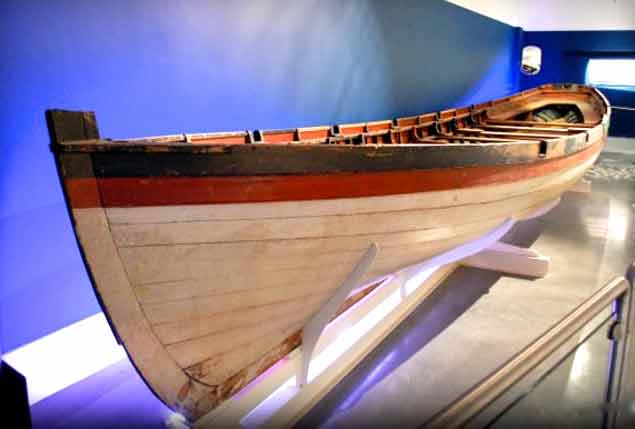 The original “Bantry Boat” – built in Brest in 1790 – is now conserved in the National Museum at Collins Barrack in Dublin
The original “Bantry Boat” – built in Brest in 1790 – is now conserved in the National Museum at Collins Barrack in Dublin
It was around 1943 or even earlier that approaches were made from Bantry House to the Irish Government about accepting responsibility for this significant historical artefact, and in 1944 the authorities took it on. But 38ft is a lot of boat, and for long enough it seemed sufficient simply to find a safe storage space until in 1974 the nascent Maritime Museum of Ireland in Dun Laoghaire took the Bantry Boat on loan as the centre-piece of its growing exhibition.
It’s wellnigh impossible to tabulate just how many projects of maritime history the polymath Hal Sisk has been involved with, both over the years and in the present time. Back in the 1970s and for subsequent decades, the Bantry Boat was just one of them. On such matters, he would be regularly in contact with his friend Bernard Cadoret of the encyclopaedic French magazine Le Chasse Maree. This splendid publication, which he founded in 1981 with his wife Michele, is heroically devoted to the cause of maritime history and culture, both nationally and worldwide. The continuing existence of the Bantry gig was something which deservedly was given minute attention, with the vessel’s lines being taken off in Ireland by Paul Kerrigan in 1977 to provide a uniquely authentic set of plans and several articles in Le Chasse Maree.
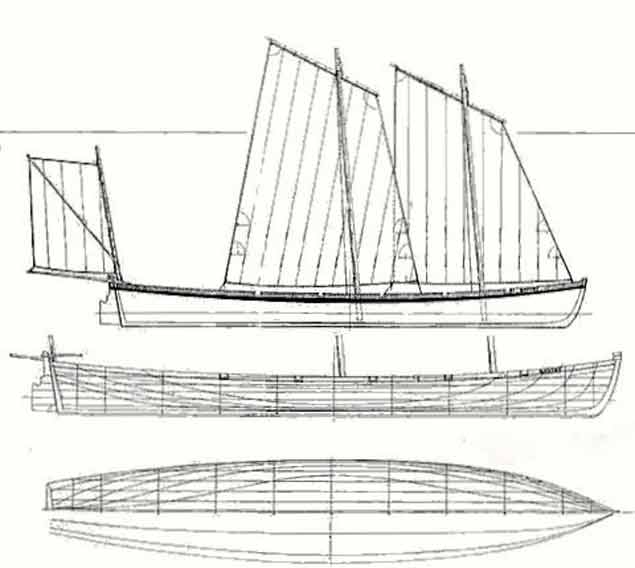 The special vintage rig of the Bantry Boat will be seen as a performance challenge by any genuine sailing enthusiast.
The special vintage rig of the Bantry Boat will be seen as a performance challenge by any genuine sailing enthusiast.
In time the actual Bantry boat herself was taken into the care of ship conservation department at Liverpool University with which John Kearon (originally of Arklow, and later to conserve the Asgard) is so closely involved, and now the gig is on permanent display in the Collins Barracks section of the National Museum in Dublin. But meanwhile the fact that the true plans were in existence had played a role in the next stage of the story.
It began in 1986 when New York Harbor saw the staging of the first Atlantic Challenge events. The brainchild of American marine philanthropist Lance Lee in consultation with Bernard Cadoret, it was based on multi-activity competition between young crews representing the US and France, using replicas of the Bantry longboat.
Recently in Afloat.ie, we’ve carried a report about how the various rowing disciplines and their specialised boat types have been trying to find enough common ground to create an umbrella body to represent the interests of a sport which is undoubtedly growing in all areas and categories, but has difficulty in speaking with a single voice. Yet whether or not the Bantry boats could ever be included in this new grouping is a moot point, for not only are they an intensive rowing experience, but sailing them is an advanced skill in itself.
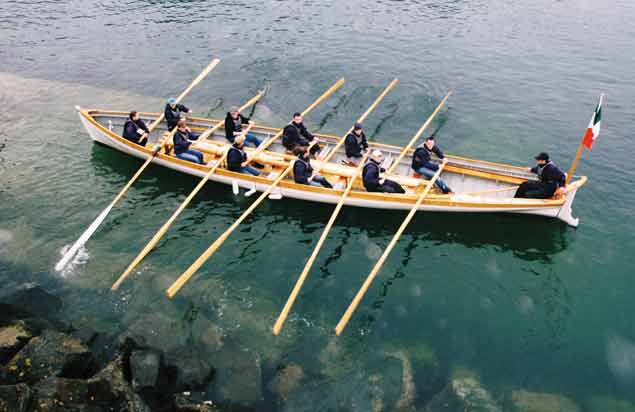 Waterford has been involved in the Atlantic Challenge concept since 2005. This photo of their boat An-Seabhac when new gives and idea of the complexity of the seamanship skills required – the ten 10ft oars have to be stowed in careful order, and the boat is rowed with the complete three-masted rig – including the sails -stowed on board.
Waterford has been involved in the Atlantic Challenge concept since 2005. This photo of their boat An-Seabhac when new gives and idea of the complexity of the seamanship skills required – the ten 10ft oars have to be stowed in careful order, and the boat is rowed with the complete three-masted rig – including the sails -stowed on board.
This was soon learned as the Atlantic Challenge developed from its modest beginnings in 1986. 1988’s was due to be staged in France, and Hal Sisk was invited to see if he could organise an Irish crew. In an inspired decision, he approached people in Bantry such as Dr Matt Murphy and Mark Wickham, and between the rowing club and the sailing club, they got a crew together and headed off to Douarnenez to compete in a borrowed boat, for building Bantry boats as a training and community exercise was becoming something of a movement in itself, and an international movement at that, as the listing of the biennial stagings of the Atlantic Challenge since its foundation reveals:
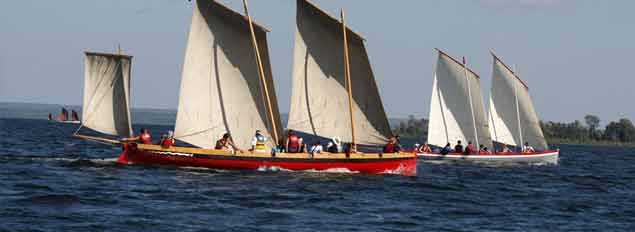 A joy to race under sail. Atlantic Challenge 2010 under way in Ontario, Canada
A joy to race under sail. Atlantic Challenge 2010 under way in Ontario, Canada
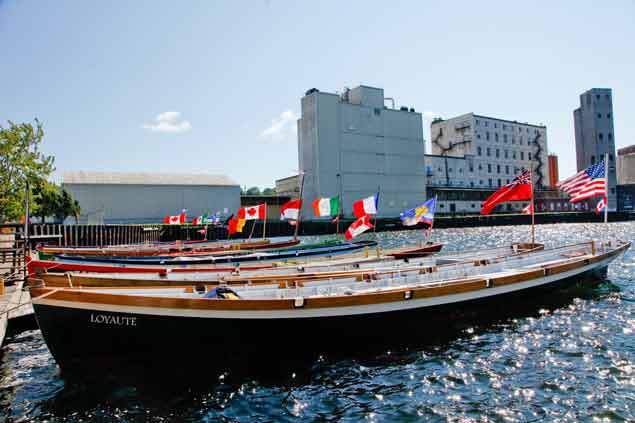 A truly international gathering – Bantry Boats in port in Canada
A truly international gathering – Bantry Boats in port in Canada
ATLANTIC CHALLENGE VENUES:
1986 New York, New York (USA
1988 Douarnenez (France)
1990 Roskilde (Denmark)
1992 Brest (France)
1994 Penetanguishene, Ontario (Canada)
1996 Bantry, County Cork (Ireland)
1998 Roskilde (Denmark)
2000 Douarnenez (France)
2002 Rockland, Maine (USA Maine)
2004 Fishguard, Wales (GB)
2006 Genoa (Italy)
2008 Jakobstad (Finland)
2010 Midland, Ontario (Canada)
2012 Bantry, County Cork (Ireland)
2014 Gulf of Morbihan (France)
2016 Roskilde (Denmark)
And now, for 2018, the Atlantic Challenge will be in Northern Ireland, on our largest lake of Lough Neagh, at Antrim Boat Club in the lake’s northeast corner from July 20th to 28th. The Lough Neagh men have form in this, as they won 2012’s international event at Bantry. But Organising Committee chairman Charlie Macallister and his team – and their clubmates in Antrim BC – are well aware of the high standards of organisation and hospitality they’ll be expected to provide. But equally there’s always the challenge of maintaining a Bantry Boat in good order, and finding, keeping, training and motivating a young crew to a level of performance and success which makes it all worthwhile.
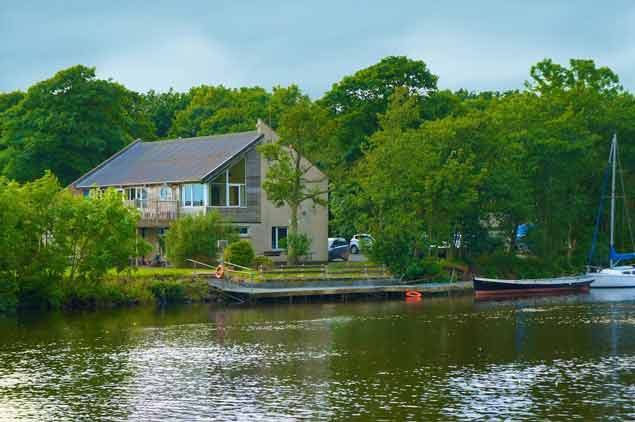 Antrim Boat Club on Lough Neagh with the local Atlantic Challenge’s first boat, the Harmonie, at the club pontoon. Antrim hosts the 2018 Atlantic Challenge from July 20th to 28th.
Antrim Boat Club on Lough Neagh with the local Atlantic Challenge’s first boat, the Harmonie, at the club pontoon. Antrim hosts the 2018 Atlantic Challenge from July 20th to 28th.
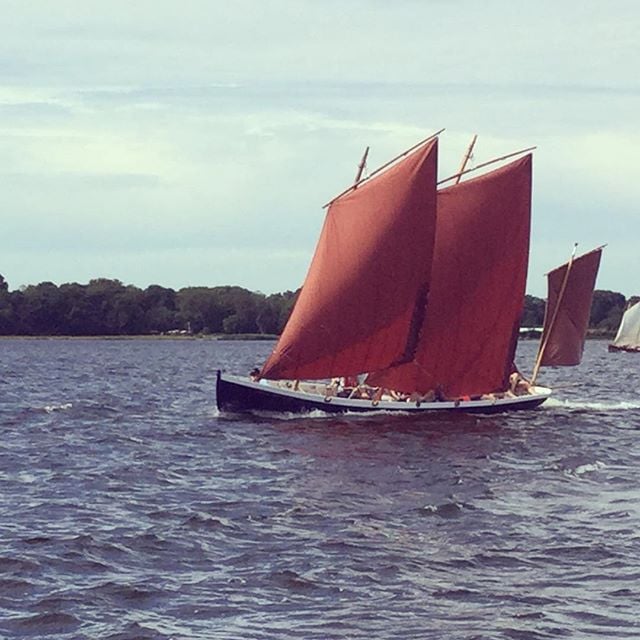 Lough Neagh Bantry Boat Harmonie making knots on her home waters
Lough Neagh Bantry Boat Harmonie making knots on her home waters
For although the ideal is to build one of the boats as a community effort, the reality is that two or three skilled boatwrights can soon build one on their own. But in order to use the boat to her full potential, you need the numbers of a football team, plus two or three extra, to provide the full crew. In an age where other forms of rowing, other forms of sailing and indeed other forms of sport and recreation are readily available as rival distractions for potential crew, that’s a formidable challenge.
Yet over the years, people have found that the attractions of setting up a local Bantry Boat project are irresistible. They provide so much in one package – a beautiful and historically significant boat which can push towards 10 knots when being rowed by her ten 10ft oars, then when it’s time for the sailing part o the competition, those huge oars have to be skillfully stowed in a strictly choreographed programme in order to allow the ancient yet very effective three-masted rig to be set up.
No-one with a taste for sailing which is decidedly different to your modern high-tech stuff could resist the challenge of getting optimum performance from a Bantry Boat’s rig. Subtle differences in the relative trim of the three sails can hugely affect performance, but it’s a joy when they get it just right – Charlie Macallister was telling me that at an event in Wales, he was aboard a support boat which timed one of the Bantry Boats smoking along at a good 16–knots under sail.
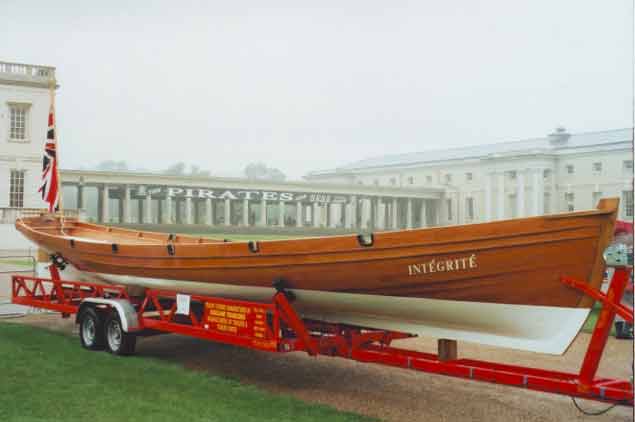 A pleasure to behold – the Atlantic Challenge Longboat Integrite makes her debut appearance at Greenwich Maritime Museum in London
A pleasure to behold – the Atlantic Challenge Longboat Integrite makes her debut appearance at Greenwich Maritime Museum in London
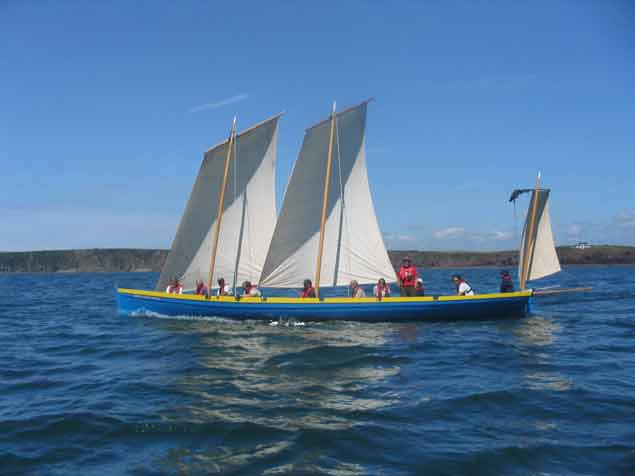 A fresh expression of a coastal town’s maritime spirit. This is the Lyme Regis boat sailing in the English Channel off the coast of Dorset
A fresh expression of a coastal town’s maritime spirit. This is the Lyme Regis boat sailing in the English Channel off the coast of Dorset
So the appeal is there, and when it works for a local community – as it does so well, for instance, at Lyme Regis in the heart of England’s south coast – then it can be a very fulfilling and beneficial project. It works, too, when there’s a certain level of official support in more structured societies. In the early 1990s, Lance Lee gave encouragement to the setting up of an Atlantic Challenge boat-building shop in Russia. That produced boats and a programme which received a level of official approval, and in time the Russians sent a build-team to Finland to help them set up something similar there.
This all acquired an extra international dimension when the Russians won the most recent Atlantic Challenge contest at the historic port of Roskilde in Denmark in 2016, which means that come July, the complex competition of rowing, seamanship skills and sailing skill on Lough Neagh will see the Russians as defending champions.
So the original idea of 1986 continues to have growing international appeal 32 years down the line, yet in Ireland while we have some high-profile Bantry Boats, numbers have always been modest, and although it’s reckoned that in all perhaps as many as 80 Bantry Boats have been built worldwide, the sad reality is that some of them have had a decidedly short active lifespan, as the initial enthusiasm and shared effort of building the boat fails to be followed by the continuous and sometimes exhausting dedication which is needed to keep such a programme alive.
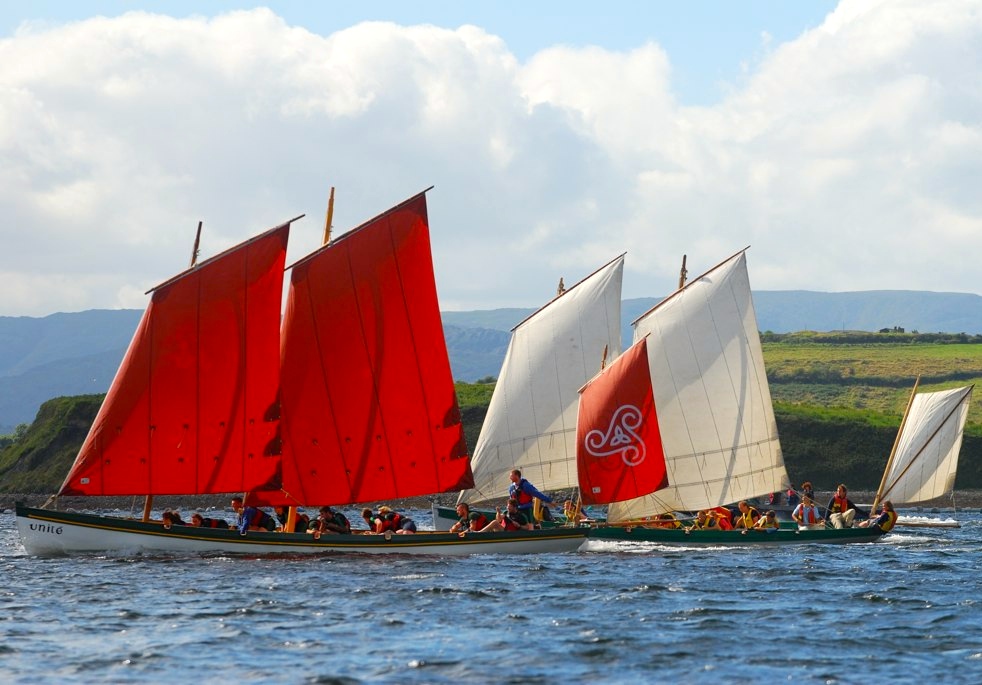 Home waters. Bantry Boats racing in the Atlantic Challenge at Bantry in 2012, when the winner was the Antrim crew with Bantry second
Home waters. Bantry Boats racing in the Atlantic Challenge at Bantry in 2012, when the winner was the Antrim crew with Bantry second
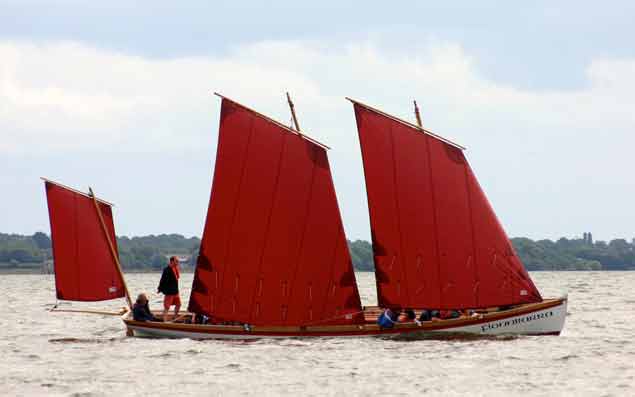 Cork’s Bantry Boat Fionnbarra, community-built by Meitheal Mara, and with rig perfectly set up.
Cork’s Bantry Boat Fionnbarra, community-built by Meitheal Mara, and with rig perfectly set up.
Yet it can be done, but it needs somewhere very special, and one of those special communities – most appropriately - is Bantry itself. There, the town’s maritime awareness has been further buoyed up by the new in-harbour marina, the place is buzzing generally as one of the main towns of increasingly prosperous West Cork, and in Diarmuid Murphy – son of Dr Matt Murphy who was one of the first Bantry people Hal Sisk went to when researching the possibilities of a Bantry crew back in 1987 – we have a total maritime enthusiast. He’s the main man at Bantry’s Fish Kitchen restaurant and the Fish Market shop, and is suitably fired up and ideally placed to keep the local 1990-built Bantry Boat Unite in proper commission and fully crewed.
His enthusiasm is infectious. He reckons the winning combination lies in Bantry’s continually-growing maritime enthusiasm and the fact that they have expanding rowing and sailing clubs side-by-side: “There’s great cross-fertilisation between the two, and guys or girls who come to us from the rowing club could end up becoming sailors, and vice versa. The too, there’s a great tradition of active team sports in West Cork in particular. Sailing or rowing a Bantry Boat is very much a team sport, and a good positive attitude helps it all along”.
Another factor is having a developing community which is growing, but not at an unhealthily fast rate. A notable contrast to Bantry in Ireland is Banagher on the Shannon, where a fine Bantry Boat was built in 2012, but with a shrinking population, the word is that these days they just can’t get the crew.
At the other end of the urban scale, the city of Genoa in Italy hosted the Atlantic Challenge in 2006 and the City Fathers had great hopes of having a local fleet. But here again we’re told they just can’t get a crew together - not because Genoa lacks population, but because there isn’t that localized sense of maritime community, with individuals prepared to give voluntarily of their time.
As for Dublin, thriving traditional coastal rowing clubs such as St Michael’s in Dun Laoghaire and Stella Maris in Ringsend already provide the energetic focal points which gather up all potential local enthusiasm, and there simply wasn’t the energy and resources space to keep a Bantry Boat on the go after one had been built in 1996. For everyone may have set out with the best of hopes, as these are seductively attractive boats, yet of the eighty built since 1986, many have faded away.
But when they prosper, it’s a wonder to behold, and everybody wants a part of them. When the Ilen Boat-building School in Limerick made a deal to provide a new paint job and some repairs to Bantry’s Unite in the winter of 2008-2009, part of the deal was that when the job was done the boat could be used to row the Mayor of Limerick John Gilligan out to Scattery Island in the Shannon Estuary for the ancient dart-throwing ceremony to remind everyone that the Mayor of Limerick is Lord Admiral of the Shannon Estuary.
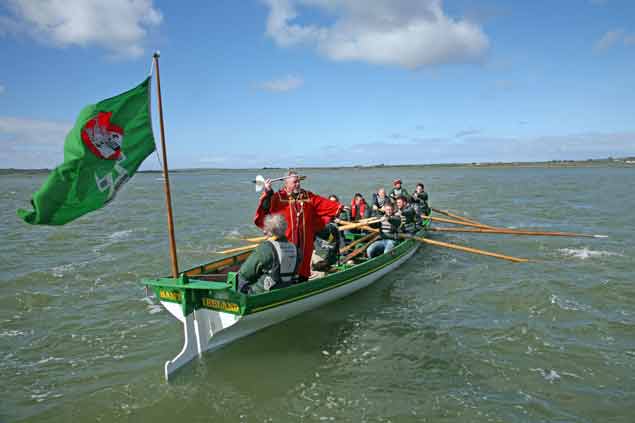 Re-fitted by Limerick’s Ilen Boat-building School, Bantry’s own Bantry Boat from West Cork provides the launch vessel when the Mayor of Limerick John Gilligan asserts his rights as Admiral of the Shannon Estuary with the ancient dart-throwing ceremony at Scattery Island. Photo: Gary MacMahon
Re-fitted by Limerick’s Ilen Boat-building School, Bantry’s own Bantry Boat from West Cork provides the launch vessel when the Mayor of Limerick John Gilligan asserts his rights as Admiral of the Shannon Estuary with the ancient dart-throwing ceremony at Scattery Island. Photo: Gary MacMahon
Such things are just grand when the boat has enjoyed a comfortable winter in the cosseted comfort of the Ilen School’s workshop. But maintaining a classically-built open 38-footer year-on-year in Ireland’s damp and windy climate is quite a challenge, and it was in pursuing this gloomy line of thought that my day was made by Diarmuid Murphy’s final cheery answer.
“Where do we store her for the winter? We store her in the unused hangar at Bantry Aerodrome” says he. There you have it, the Third Sacred Secret in the success of Bantry’s own longboat. And no, I didn’t know either that Bantry had its own little airstrip – but they do. And as there’s space in the hangar for Cork’s own Bantry Boat too, they give her winter sanctuary as well.
It rounds out the story. Bantry, by having the prefect preservation pod in the Bantry House Boathouse, kept the longboat alive and well until she was 154 years old. After that, she was taken over by others, and now at 228 years old, is safely conserved in the National Museum.
And as for some of the active descendants in Ireland, it’s the fortuitous presence of a disused hangar at Bantry Aerodrome which is central to their comfortable survival. When it all comes together on Lough Neagh on 20th July, this extraordinary story will open a new chapter. And it’s anyone’s guess where that will lead.
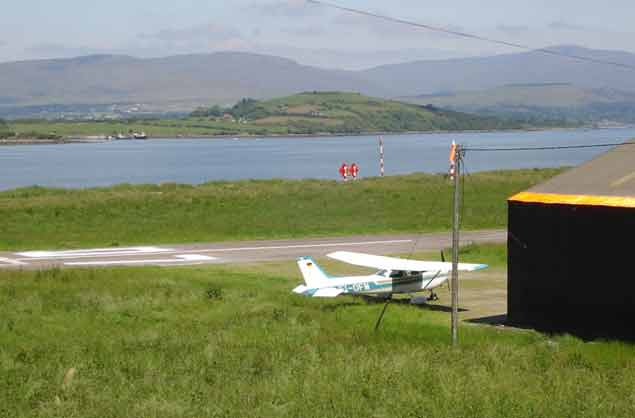 Bantry’s best-kept secret – the airstrip. The under-used hangar on the right is ideal for sheltering two Bantry Boats through the winter.
Bantry’s best-kept secret – the airstrip. The under-used hangar on the right is ideal for sheltering two Bantry Boats through the winter.



























